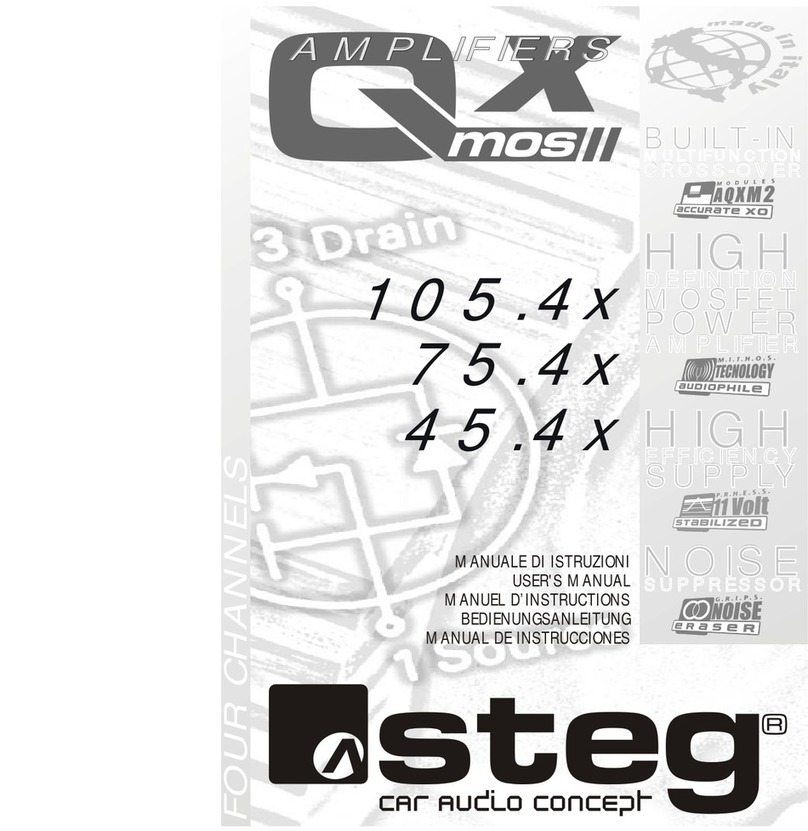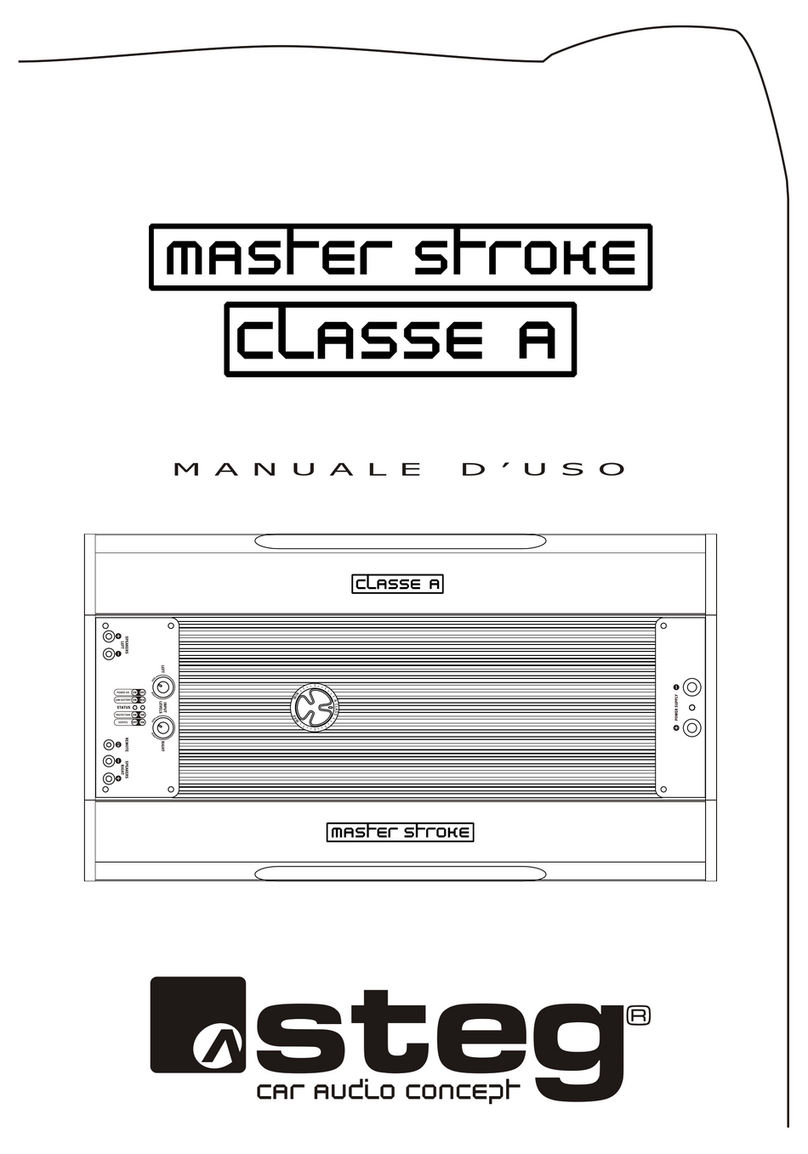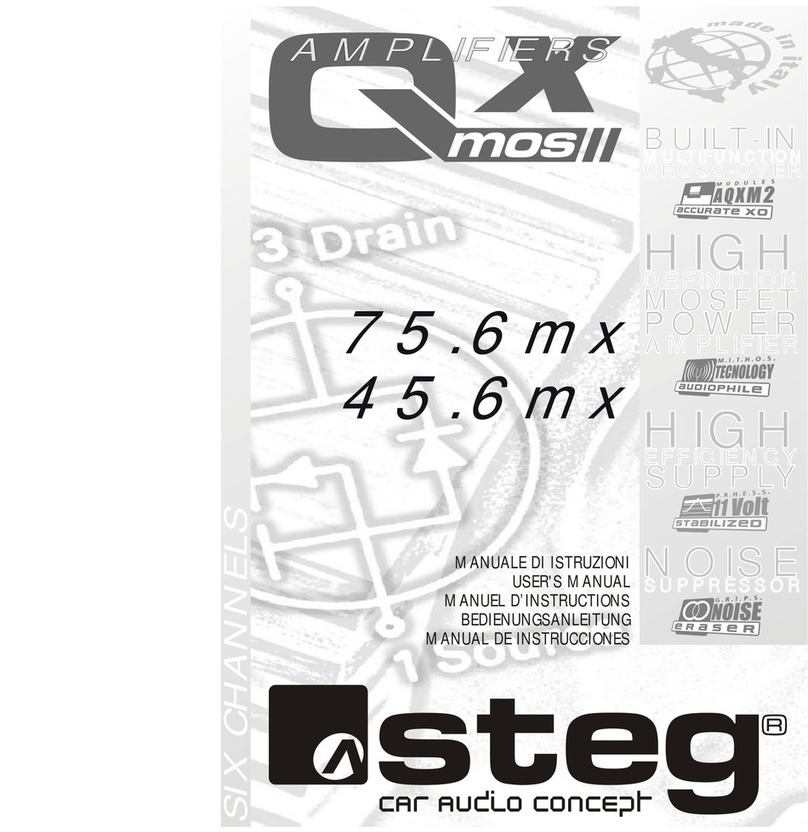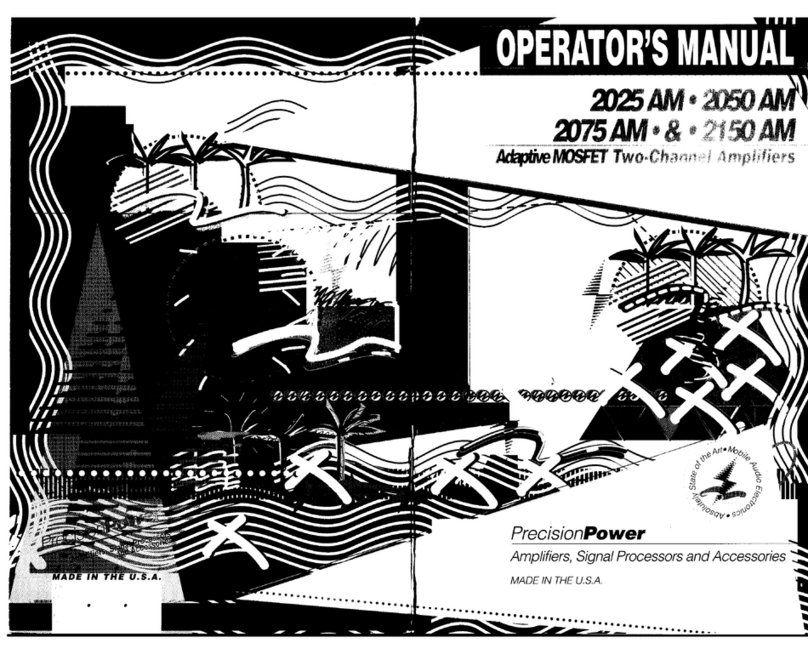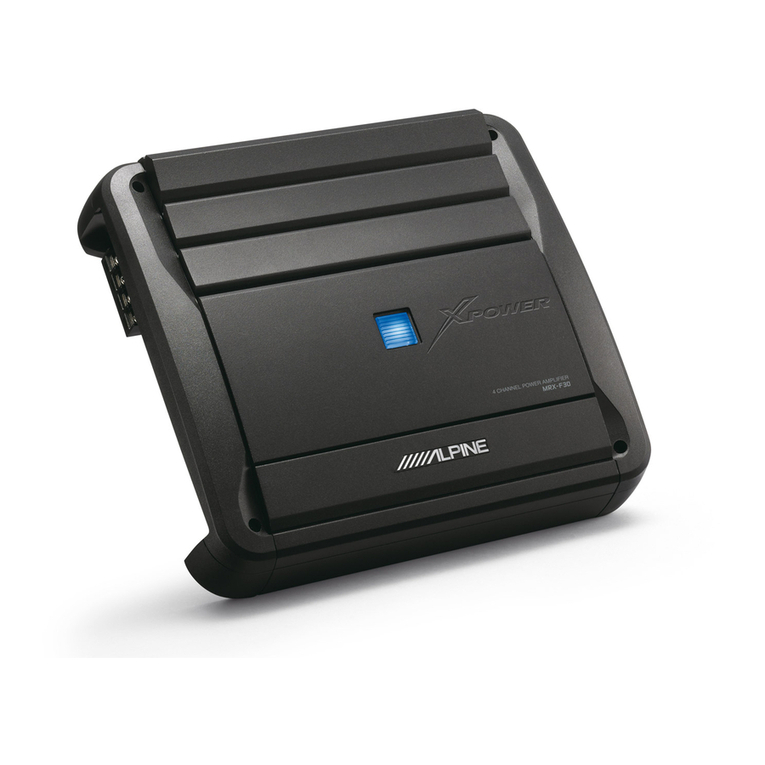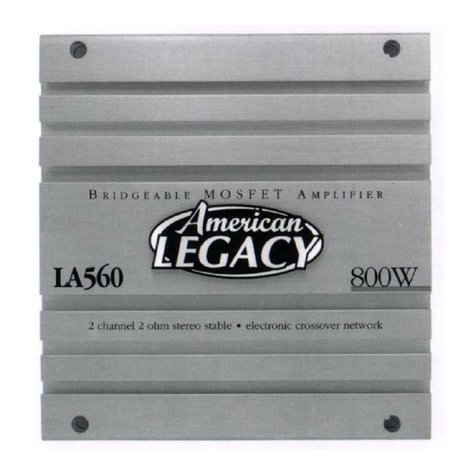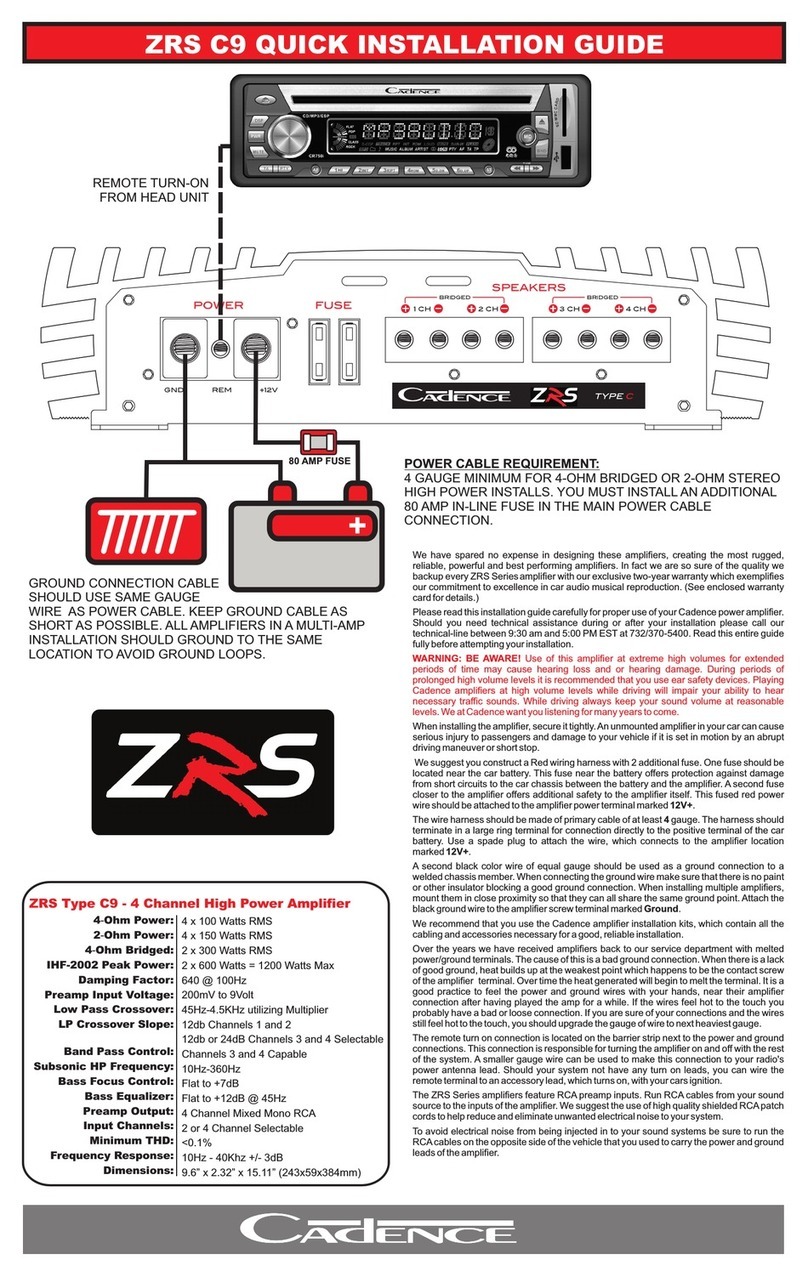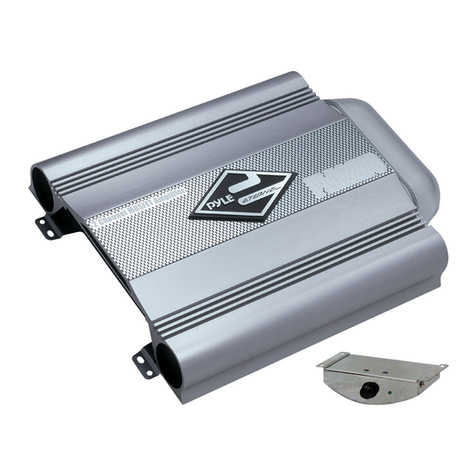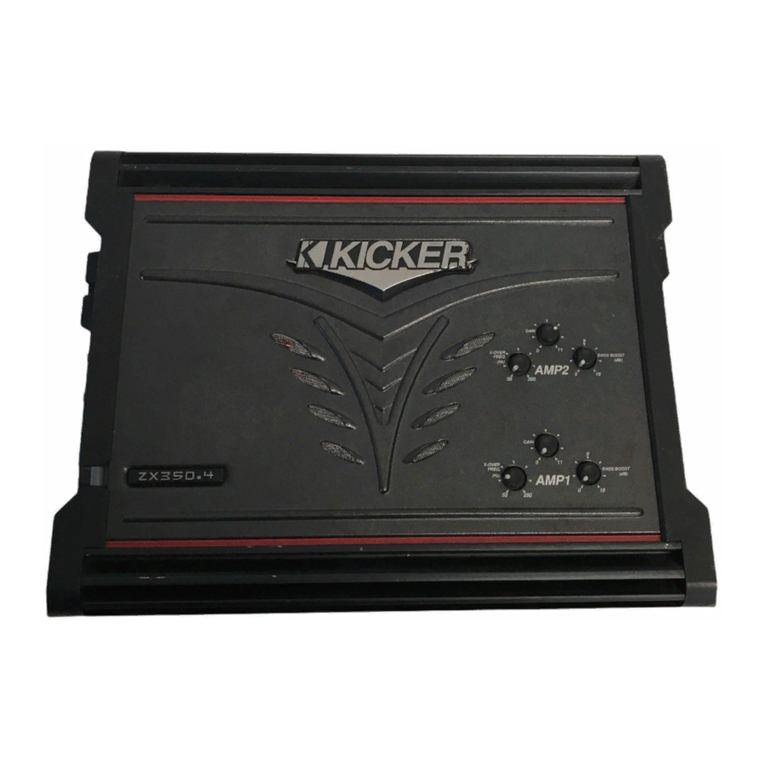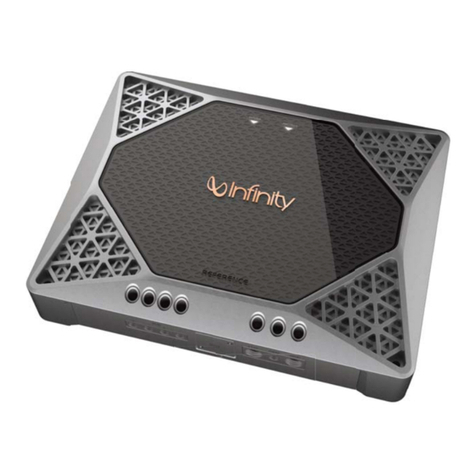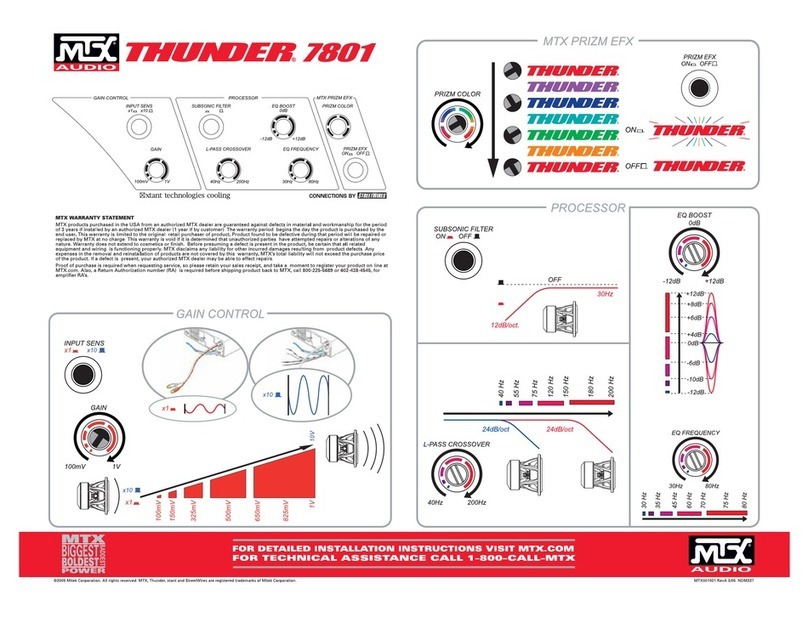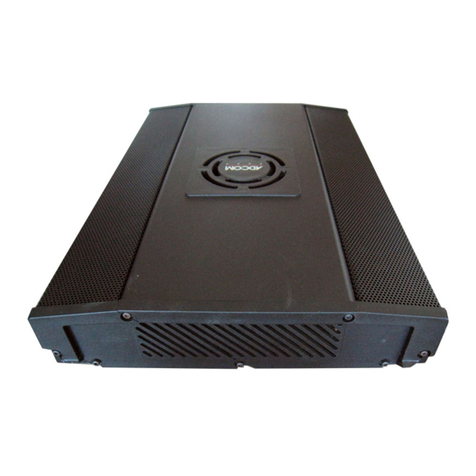Steg Qx mos 150.1X User manual

MANUALEDIISTRUZIONI
USER'SMANUAL
MANUELD’INSTRUCTIONS
BEDIENUNGSANLEITUNG
MANUALDEINSTRUCCIONES
ONE CHANNEL
AMPLIFIERSAMPLIFIERS
1x
240.
150.1x
DEFINITIONDEFINITION
MOSFETMOSFET
POWERPOWER
AMPLIFIERAMPLIFIER
HIGHHIGH
EFFICIENCYEFFICIENCY
SUPPLYSUPPLY
HIGHHIGH
SUPPRESSORSUPPRESSOR
NOISENOISE
CROSS-OVERCROSS-OVER
MULTIFUNCTIONMULTIFUNCTION
BUILT-INBUILT-IN

PAGE N° REFERENCE
00A REM
FUSE SUPPLY OUTPUT
LOW12
R
LLEVEL
V3,50,15
FILTER
PHASE
1
0,5
Hz
120 40
FREQUENCY dB
12 0
BOOST
ON
PRT
1224SLOPE-dBLOW
HIGH
“Q”FACTOR OFF
0
ON
180
RL
XOVER MODE OUTPUT INPUTPAR BOOST
AQXM2 CUT FREQ. MODULES BOTTOM SIDE
STABILIZED
Stereo 4 Ω power
2 Ω power
Overall efficiency
Overall efficiency
Frequency response LOW
Frequency response HIGH
Distortion
Intermodulation distortion
Linear noise-signal
Damping factor
Input sensitivity
Input impedance
Supply range
Max. power absorption
Fuse
Dimensions
Weight
Potencia 4 Ω
Potencia 2 Ω
Rendimiento global
Rendimiento global
Respuesta en Frecuencia LOW
Respuesta en Frecuencia HIGH
Distorsión
Distorsión de Intermodulación
Señal-ruido lineal
Factor de atenuación
Sensibilidad de entrada
Impedencia de entrada
Rango de la alimentación
Absorción máxima potencia
Fusible
Dimensiones
Peso
Potenza 4 Ω
Potenza 2 Ω
Rendimento globale
Rendimento globale
Risp. in Frequenza LOW
Risp. in Frequenza HIGH
Distorsione
Distors. di Intermod.
Segnale-rumore min. sens.
Fattore smorzamento
Sensibilità ingresso
Impedenza ingresso
Range di Alimentazione
Assorb. massima potenza
Fusibile
Dimensioni
Peso
Leistung 4 Ω
Leistung 2 Ω
Gesamtleistungsabgabe
Gesamtleistungsabgabe
Frequenzgang LOW
Frequenzgang HIGH
Verzerrung
Klirrfaktor
Linearer Fremdspannungsabstand
Dämpfungsfaktor
Eingangsempfindlichkeit
Eingangsimpedanz
Bereich der Stromversorgung
Max. Leistungsaufnahme
Sicherung
Abmessungen
Gewicht
Puissance 4 Ω
Puissance 2 Ω
Rendement global
Rendement global
Réponse en Fréquence LOW
Réponse en Fréquence HIGH
Distorsion
Distorsion d'intermodulation
Signal-bruit linéaire
Facteur d'amortissement
Sensibilité d'entrée
Impédance d'entrée
Plage d’alimentation
Absorption puissance maximale
Fusible
Dimensions
Poids
1channel
Caratteristiche Tecniche - Technical Characteristics -
- Caractéristiques Techniques
Technische Daten Características Técnicas
12-15 10-11 8-96-7
Cut Freqency Hz
25,30,33,35,38,40,45,
50,55,60,65,70,75,80,85,90,95,100,
110,120,130,150,180,200,250,300,350,
400,450,500,600,700,800,900,1000,
1100,1200,1300,1400,1500,1800,2000,
2500,3000,3500,4000,4500,5000,
5500,6000,6500,7000,7500,8000,8500.
4-5
150W x 1
150W x 1
250W x 1
>60%
>60%
20÷8.500
20÷60.000
<0,05%@1Khz
<0,01%
>90(>95)
>500
0,15÷ 3,5
>11
10,5÷ 16
20
25
207x5 2 x 213
1.950
240W x 1
240W x 1
430W x 1
>60%
>60%
20÷8.500
20÷60.000
<0,05%@1Khz
<0,01%
>90(>95)
>500
0,15÷ 3,5
>11
10,5÷ 16
32
40
207x 52 x 289
2.650
AMPLIFIERSAMPLIFIERS
QMos II amplifiershavea stabilized
internal power supply. The technical
characteristics are obtained (and do
not alter) with a power supply voltage
ofbetween11 and14.4V. Theampli-
fiers are built and dimensioned to
supply power exceeding the declared
rating. The value is indicated as "typi-
cal power". The power declared is in
any case the minimum guaranteed
and always verifiable on the amplifier,
independent of the tolerances of the
componentsusedin itsconstruction.
G.T. TRADING reserves the right to
make any technical and aesthetic
modifications to the product without
priornotice.
GliamplificatoriQMos II hannoali-
mentazione interna stabilizzata. - Le
caratteristiche tecniche sono ottenute
(e non variano) con tensione di ali-
mentazionecompresafra 11 e14,4V.
- Gli amplificatori sono costruiti e di-
mensionatiperfornire unapotenzasu-
periore a quella dichiarata. Le poten-
zedichiaratesono comunquelemini-
me garantite e sempre riscontrabili
sull’amplificatore, indipendentemen-
te dalle tolleranze della componenti-
sticausataper lacostruzione.
G.T. TRADING comunica che i pro-
dotti possono subire variazioni tecni-
cheed estetiche senzapreavviso alcu-
no.
Die VerstärkerQMos II weisen eine
interne stabilisierte Speisung auf. Die
(änderungsfreien) technischen Eigen-
schaften werden bei einer Speisung
mit einer Spannung zwischen 11 und
14,4V erzielt. Die Verstärker sind
dafürausgelegt,eine höherealsdie an-
gegebene Leistung abzugeben. Der
Wertwirdals"typischeLeistung"ange-
geben. Die angegebenen Leistungen
sind die garantierten Mindestleistun-
gen, die der Verstärker unabhängig
von den Toleranzen der für die Her-
stellung verwendeten Komponenten
immeraufweist.
G.T. TRADING behält sich das Recht
vor,ohneVorankündigung technische
Änderungen sowie Änderungen am
Aussehen der Produkte vorzuneh-
men.
Les amplificateurs QMos II ont une
alimentationinternestabilisée. Les ca-
ractéristiques techniques sont obte-
nues(etne changentpas)avec uneten-
siond'alimentationcomprise entre 11
et14,4V. Lesamplificateurssont con-
struits et dimensionnés pour fournir
une puissance supérieure à celle dé-
clarée. La valeur est indiquée comme
"puissancetypique". Detoutes lesma-
nières les puissances déclarées sont
les minimums garanties et vérifiables
sur l'amplificateur, indépendamment
destolérances descomposants utilisés
pourlaconstruction.
G.T. TRADING communique que les
produits sont à tout moment suscepti-
bles d'évolution ou de modifications,
tantauplan techniquequed'aspect.
Los amplificadores QMos II poseen
la alimentación interna estabilizada.
Las características técnicas son inva-
riablesyhansidomedidascontensión
de alimentación comprendida entre
11y 14,4V.Los amplificadoreshan si-
do proyectados para suministrar una
potenciasuperiora ladeclarada.El va-
loresindicadocomo "potenciatípica".
De todos modos, las potencias decla-
radas son las mínimas garantizadas y
siemprese encuentranindicadas enel
amplificador, independientemente
de las tolerancias de los componentes
utilizadosparasu fabricación.
G.T. TRADING comunica que los
productos pueden sufrir variaciones
técnicasyestéticas sinprevioaviso.
RMS- 11V
RMS- 14V
RMS
maxpow. 4 Ω- 11V
maxpow. 2 Ω- 11V
Hz-3 dB
Hz-3 dB
stereo4 Ωmax pow
4Ωmax pow. DIM 100
dB(“A” weight)
4Ω- 1kHz
VoltRMS
Kohm
V. Batt
4Ω- A
A
mm.
Kg.
MODELS
MODELS
1channel1channel
240.1x
150.1x

1a
1b
1c
1d
2a
2b
3a ONPRT
ONPRT
ONPRT
1
2
3
1Posizione dell’amplificatore.
Non posizionare l’amplificatore sotto
moquette o in vani con superfici a contatto
del dissipatore che non permetterebbero un
adeguatoscambio dicalore.
E’ importante anche il verso di installazione
dell’amplificatore, la sua forma è
appositamente studiata per collocazioni
come quelle indicate nelle (fig. a,b,c,) che
garantiscono la migliore dissipazione di
calore. La posizione indicata dalla (fig. d) è
assolutamente da evitare poichè non
permette un regolare funzionamento dello
stesso. Gli amplificatori steg sono
comunque protetti contro i surriscaldamenti
e quando le protezioni entrano in funzione
(85°C) l’amplificatore smette di funzionare
per riprendere appena la temperatura del
dissipatore scende di qualche grado sotto la
sogliadi protezione.
2Fissaggio dell’amplificatore.
Per prevenire danni alle persone,
all’amplificatore o alla vettura fissate bene
l’amplificatore, in un punto sicuro. Gli
amplificatori QMOSII si avvalgono di un
sistema di fissaggio semplice ed efficace (fig.
a). I quattro piedini forniti a corredo vanno
inseriti lungo la scanalatura del dissipatore e
possono essere posizionati in un punto
qualsiasi della lunghezza dello stesso (fig.b)
così da permettere il fissaggio anche su
superfici che non consentono quattro fori a
distanza regolare. Stabilite le posizioni dei
piedini basta bloccarli avvitando le viti
autofilettantifornite acorredo.
3Stato dell’amplificatore (STATUS).
Sul pannello frontale dell’ amplificatore si
trovano i due LED di verifica dello stato di
funzionamentodell’amplificatore (fig.a).
1-VERDE: Infunzione.
2-VERDE+ROSSO: Stato di muting per
protezionetermica ocortocircuitosulla linea
altoparlanti.
3-ROSSO: Malfunzionamento
dell’amplificatore che smette di funzionare
per prevenire danni agli altri componenti
dell’impianto collegati all’uscita. Se
l’amplificatore rimane in questo stato
consigliamo di rivolgersi al rivenditore
steg.
1Amplifier position.
Do not place the amplifier under moquettes
orin spaces with surfaces incontactwiththe
heat-sink,since thiswouldpreventadequate
heatexchange.
Also the direction of installation of the
amplifier is important; its shape is specially
designedfor positioning as shown inthe
which guarantees the best heat
dissipation. The position as shown in
is absolutely to be avoided, since it does not
allow regular functioning of the amplifier.
amplifiers are, however, protected
against overheating; when the protections
are activated (85°C), the amplifier stops
working and starts again only after the
temperature of the heat-sink goes down to a
fewdegrees belowtheprotectionthreshold.
2Fixing the amplifier.
To prevent damage to persons, the amplifier
or the vehicle, firmly fix the amplifier in a
safe place. The amplifiers can be
fitted in a simple and efficient way (fig. a).
Thefourfeetprovidedareinserted along the
heat-sink groove and can be positioned at
any point along its length (fig. b), and can
thus also be fitted onto surfaces where four
evenly-spacedholescannotbemade. Once
the foot positions have been established,
lockthembyscrewing downtheself-tapping
screwsprovided.
3Amplifier state (STATUS).
On the front panel of the amplifier are two
LEDs which indicate the amplifier operating
state(fig. a)
1-GREEN:on.
2-GREEN+RED: Muting state for thermal
cut-outor short-circuitonthespeakerline.
3-RED: Malfunctioning of the amplifier
which stops working to prevent damage to
the other system components connected to
the output. Should the amplifier remain in
this state, it is advisable to contact a
dealer.
(fig.
a,b,c,) (fig.d)
steg
QMOSII
steg
1Position de l'amplificateur.
Ne pas placer l'amplificateur sous de la
moquette ou dans des emplacements ayant
des surfaces en contact avec le dissipateur,
carcela empêcherait un échange de chaleur
approprié.
Le sens d'installation de l'amplificateur est
également important. En effet, sa forme est
spécialement étudiée pour des installations
comme celles indiquées sur les
garantissant la meilleure dissipation de la
chaleur. La position indiquée sur la
doit impérativement être évitée parce
qu'elle ne permet pas un fonctionnement
régulier de ce dernier. Les
amplificateurs sont protégés contre
les é
chauffements et lorsque les protections
s'enclenchent (85°C) l'amplificateur arrête
de fonctionner pour reprendre dès que la
température du dissipateur descend de
quelques degrés au-dessous du seuil de
protection.
2Fixation de l'amplificateur.
Pour éviter des accidents aux personnes et
dedétériorerl'amplificateurouà lavoiture,il
faut bien fixer l'amplificateur dans un point
sûr. Les amplificateurs ont un
systèmede fixationsimpleetefficace(fig.a).
Les quatre pieds fournis dans la confection
doivent être introduits dans la rainure du
dissipateur et peuvent être placés à
n'importe quel endroit le long de ce dernier
(fig.b)permettantainsila fixation, même sur
dessurfacesneconsentantpasquatre trousà
distance régulière. Après avoir établi les
positions des pieds il nereste plus qu'à les
bloquer en vissant les vis autotaraudeuses
fourniesen équipement.
3Etat de l'amplificateur (STATUS).
Deux VOYANTS lumineux, pour le contrôle
de l'état de fonctionnement de
l'amplificateur, se trouvent sur le panneau
avantde cedernier.(fig.a)
1-VERTÊ: enfonction.
2-VERT+ROUGEÊ: Etat d'alarme pour
protection thermique ou court-circuit sur la
lignedes haut-parleurs.
3-ROUGEÊ: dysfonctionnement de
l'amplificateur qui s'arrête de fonctionner
pour éviter toute détérioration aux autres
composants de l'installation reliés à la sortie.
Si l'amplificateur reste cette situation il est
conseilléde contacterlerevendeur .
(fig. a,b,c,)
(fig.d)
steg
QMOSII
steg
1Position des Verstärkers.
Positionieren Sie den Verstärker nicht unter
Teppichbodenoder in Fächern, diemitdem
Wärmedissipator in Kontakt kommen und
eine angemessene Abstrahlung der Wärme
verhindern.
Auch die Einbaurichtung des Verstärkers ist
wichtig; seine Form wurde eigens für die
(Abb. a,b,c) Installationsweisen entwickelt,
die die beste Wärmeabstrahlung
gewährleisten. Die auf der (Abb. d) gezeigte
Position muss unbedingt vermieden
werden, da sie keinen ordnungsgemäßen
Betrieb des Verstärkers gestattet. Die
Verstärker sind gegen Überhitzung
geschützt und wenn die
Schutzvorrichtungen eingreifen (85°C), wird
der Verstärker abgeschaltet; er wird wieder
eingeschaltet, sobald die Temperatur des
Dissipatorswiederum einige Grad unter der
Schutzschwelleabfällt.
2Anbringung des Verstärkers.
Befestigen Sie den Verstärker zur
Vermeidung von Schäden an Personen, am
Verstärker oder am Fahrzeug an einem
sicheren Punkt. Die Verstärker
weisen ein einfaches und effizientes
Befestigungssystem auf (Abb. a). Die vier
mitgelieferten Füßchen werden in die
Kehlen des Dissipators eingesteckt und
können an einem beliebigen Punkt auf der
Länge desselben positioniert werden
(Abb.b), um die Befestigung auch auf
Oberflächen zu gestatten, die keine vier
Bohrungen mit gleichmäßigem Abstand
gestatten. Nach dem Festlegen der
Positionen der Füßchen müssen sie lediglich
mit den mitgelieferten selbstschneidenden
Schraubenarretiert werden.
3Status des Verstärkers (STATUS).
Auf dem Frontpaneel des Verstärkers
befinden sich zwei Leds für den
Betriebsstatusdes Verstärkers(Abb.a)
1- GRÜN:InBetrieb.
2-GRÜN+ROT: Muting-Status aufgrund
von Überhitzung oder Kurzschluss der
Lautsprecherleitung.
3-ROT: Funktionsstörung des Verstärkers,
der abgeschaltet wird, um Schäden an
anderen am Ausgang angeschlossenen
Komponenten der Anlage zu verhindern.
Wenden Sie sich an Ihren -Händler,
wennder VerstärkerindiesemStatusbleibt.
steg
QMOSII
steg
1 Ubicación del amplificador
No instalar el amplificador debajo de
moquetas o en alojamientos con superficies
a contacto con el disipador, que no
permitirían un apropiado intercambio de
calor.
También es importante el sentido de
instalación del amplificador, dado que su
forma ha sido especialmente proyectada
para instalaciones como las indicadas en las
(fig.a,b,c), que garantizan la mejor
dispersión del calor. La posición indicada en
la (fig. d) debe ser absolutamente evitada,
dado que no permite un buen
funcionamiento del aparato. De todos
modos, los amplificadores están
protegidos contra los recalentamientos y,
cuandolosdispositivosde protección entran
en funcionamiento (85°C), el amplificador
se detiene, retomando más tarde su
funcionamiento ni bien la temperatura del
disipador descienda algunos grados por
debajodel límitedeprotección.
2Fijación del amplificador
Para prevenir daños a las personas, al
aparato o al automóvil, es importante fijar
bienel amplificadorenunpuntoseguro.
Los amplificadores están dotados
de un sistema de fijación sencillo y eficaz
(fig. a). Los cuatro pies que se entregan con
el equipamiento se aplican a lo largo de la
ranura del disipador y se fijan en cualquier
punto de la misma (fig. b), para facilitar la
instalación aún sobre superficies que no
permitenrealizarcuatroorificios a distancias
regulares. Una vez establecidas las
posicionesde los pies, essuficientetrabarlos
ajustandolostornillos que seentreganconel
equipamiento.
3Estado del amplificador (STATUS).
Sobre el panel delantero del amplificador se
encuentran los dos LED de control del
estado de funcionamiento del amplificador:
(fig.a)
1- VERDE:Enfuncionamiento.
2-VERDE+ROJO: Estado de "muting"
(reducción del volumen sonoro) como
protección térmica o de cortocircuito en la
líneade losaltoparlantes.
3-ROJO: Desperfecto del amplificador, que
deja de funcionar para prevenir dañ
os a los otros componentes del equipo
conectados a la salida. Si el amplificador
permanece en este estado se aconseja
ponerse en contacto con el revendedor
.
steg
QMOSII
steg
STATUS
pag. 5

4a
4b
4c
4d
4e
REM
pag. 7
4Alimentazioni(SUPPLY).
Stabilita la posizione definitiva
dell’amplificatore tagliate le lunghezze dei
cavi in eccesso e inseriteli nell’apposita
morsettieraSUPPLY (fig.a).
(fig.b) Positivo(SUPPLY“+”).
Il cavo di alimentazione utilizzato deve
esseredi adeguatasezione.
E’ importante sapere che maggiore è la
sezione del cavo utilizzato, migliori sono le
prestazioni dell’amplificatore. Per effettuare
il passaggio del cavo di alimentazione
consigliamo di evitare curve troppo
accentuate, attorcigliamenti e passaggi
all’interno di lamiere taglienti senza l’uso di
appositi gommini. Installare un fusibile il più
possibile vicino alla batteria per proteggere
lalineadialimentazione.Il valoredelfusibile
deveesseresuperiore alla somma dei fusibili
richiestidallealtreelettronichecollegatealla
lineadi alimentazione.
(fig. c) Negativo (SUPPLY “-”).
Il cavo di massa deve essere di sezione
uguale o superiore a quella di alimentazio-
ne. La lunghezza deve essere il minimo
indispensabile per raggiungere un punto
metallico della scocca della vettura.
Sverniciare e pulire bene il punto in cui il
cavo, opportunamente terminato con un
capocorda ad occhiello, deve essere
collegato. Serrare bene il terminale con una
vite di buone dimensioni ricordando di
inserire una rondella antisvitamento per
essere sicuri che non si allenti nel tempo. Se
per collegare il capocorda ad occhiello si
deveeffettuareunforo,ispezionareprimale
parti adiacenti per non recare danni ad
organiimportanti dell’auto.
ATTENZIONE ! Un contatto di massa di
qualità scadente si traduce in una
diminuzione della potenza e in un
peggioramento della qualità e del rumore di
tuttol’impianto.
(fig.d) Accensione(SUPPLY“REM”).
Collegare un cavo della sezione di circa
1mmallasorgente dotata di commutatore di
accensione (uscita dedicata o uscita per
antenna elettrica). Per il tragitto del cavo
dalla sorgente all’amplificatore usare le
stesse precauzioni del cavo di alimentazio-
ne.
(fig. e) Fusibile (FUSE).
In caso di bruciatura il fusibile deve essere
sostituito con uno di pari valore. Il corretto
valore del fusibile di ogni modello qMOSII
è indicato nelle caratteristiche tecniche di
questomanuale.
Intervenire sempre con i terminali di
alimentazione della batteria scollegati.
4Feeders(SUPPLY).
Always operate with the battery feeder
terminals disconnected. Once the final
position of the amplifier has been
established, cut off the excess cables and
insert them in the special terminal board
SUPPLY(fig. a)
(fig.b) Positive(SUPPLY"+").
The power cable used must have an
adequatecross-section.
N.B. The greater the cross-section of the
cable,the higher the amplifierperformance.
When running the power cable it is
recommended to avoid too sharp curves,
twists and passage through sharp metal
without the use of special rubber pieces.
Install a fuse as close as possible to the
battery to protect the feeder. The fuse value
must be greater than the sum of the fuses
required by the other electronic parts
connectedto thefeeder.
(fig.c) Negative(SUPPLY"-").
The ground cable must have a cross-section
equal to or greater than the power cable.
The length must be the minimum
indispensable to reach a metallic point on
the vehicle body. Remove the paint and
thoroughly clean the point at which the
cable, appropriately terminated with an
eyelet terminal, is to be connected. Tighten
the terminal well with a good-sized screw,
remembering to insert a washer to prevent
thatthe screwloosenswithtime.
If a hole needs to be made to connect the
eyelet terminal, first examine the adjacent
parts to prevent causing damage to
importantparts ofthevehicle.
WARNING ! A poor-quality ground contact
meansadropinpowerandworseningof the
qualityand noiseofthewholesystem.
(fig.d) Switching on(SUPPLY"REM").
Connectacableofabout1mm cross-section
to the source equipped with ignition switch
(dedicated output or output for electric
antenna). For the cable passage from the
source to the amplifier use the same
precautionsas forthepowercable.
(fig.e) Fuse(FUSE).
In case a fuse is blown, it must be replaced
with one of the same value. The correct
value of each -model fuse is
indicated in the technical characteristics in
thismanual.
qMOSII
4Alimentations(SUPPLY).
Lorsqu'on intervient les cosses
d'alimentation de la batterie doivent
toujours être déconnectées. Dès que la
position définitive de l'amplificateur est
établie, couper les longueurs des câbles en
trop et les introduire dans le bornier
appropriéSUPPLY (fig.a)
(fig.b) Positif(SUPPLY"+").
Lecâbled'alimentation utilisé doit avoir une
sectionappropriée.
Il est important de savoir que plus la section
du câble utilisé sera importante, meilleures
seront les performances de l'amplificateur.
Pour effectuer le passage du câble
d'alimentation il est conseillé d'éviter les
courbes trop importantes, des
entortillements et des passages à l'intérieur
de tôles coupantes sans l'utilisation
d'éléments en caoutchouc prévus à ceteffet.
Installer un fusible le plus près possible de la
batterie pour protéger la ligne
d'alimentation. La valeur du fusible doit être
supérieure au total des deux fusibles
demandés par les autres dispositifs
électroniquesreliés àlaligned'alimentation.
(fig.c) Négatif(SUPPLY"-"Ê).
Le câble de masse doit avoir une section
identique ou supérieure à celle
d'alimentation. La longueur doit être le
minimum indispensable pour atteindre un
point métallique de la carrosserie de la
voiture. Oter la peinture et bien nettoyer le
point où le câble, au bout duquel est
montée une cosse à oeillet, doit être
connecté. Bien serrer la cosse à l'aide d'une
visauxdimensions appropriées,sansoublier
d'insérer une rondelle contre le dévissage
accidentel pour certain qu'elle ne se
desserrerapas avecletemps.
Si pour connecter la cosse à oeillet il faut
percer un trou, contrôler d'abord les parties
environnantesafind'éviterdedétériorer des
organesimportants duvéhicule.
ATTENTIONÊ ! Un contact de masse de
mauvaise qualité signifie une diminution de
lapuissanceet une aggravationdelaqualité,
ainsi que du niveau sonore de toute
l'installation.
(fig.d) Allumage(SUPPLY"REM")
Connecter un câble ayant une section
d'environ 1 mm, à la source équipée d'un
commutateur d'allumage (sortie réservée ou
sortie pour antenne électrique). Pour le
parcours du câble, de la source à
l'amplificateur, prendre les mêmes
précautions que pour le câble
d'alimentation.
(fig. e) Fusible (FUSE).
Si le fusible est grillé il faut le remplacer par
un ayant la même valeur. La valeur exacte
du fusible pour chaque modèle
est indiquée dans les caractéristiques
techniquesde cemanuel.
qMOSII
4Speisung(SUPPLY).
Eingriffe an den anschlüssen der speisung
immer bei abgeklemmter batterie
vornehmen. Nach dem Festlegen der
definitiven Position des Verstärkers die Kabel
auf die richtige Länge schneiden und in die
entsprechende Klemmleiste SUPPLY
einstecken(Abb. a)
(abb.b) Plus(SUPPLY"+").
Das für die Speisung verwendete Kabel muss
einenangemessenen Querschnittaufweisen.
Es muss beachtet werden, dass die Leistung
des Verstärkers desto besser ist, je größer der
Querschnitt des Kabels ist. Bei der Führung
des Speisungskabels sollten enge Kurven,
Verwicklungen und Durchführung durch
schneidende Bleche ohne die Verwendung
von entsprechenden Gummistopfen
zuvermeiden. Installieren Sie eine Sicherung
so nahe wie möglich an der Batterie, um die
Speisungsleitung zu schützen. Der Wert der
Sicherung höher als die Summe der sonstigen
an die Speisungsleitung angeschlossenen
elektronischen Geräte geforderten
Sicherungensein.
(abb.c) Minus(SUPPLY"-").
Das Massekabel muss den gleichen oder
einen größeren Querschnitt als das
Speisungskabel aufweisen. Die Länge des
Kabels sollte auf das Minimum reduziert
werden, das für das Erreichen eines
metallischen Punktes der Fahrzeugkarosserie
erforderlich ist. Den Punkt, an dem das Kabel
mit einem entsprechenden Kabelanschluss
mitÖseangebrachtwerdensoll,sorgfältigvon
Lack befreien und reinigen. Den Anschluss
mit einer richtig bemessenen Schraube
anziehen und eine Sicherungsscheibe
zwischenlegen,damit die Schraube sich nicht
mitder Zeitlockert.
Falls für die Anbringung des Kabelanschlusses
mit Öse gebohrt werden muss, so müssen die
angrenzenden Bauteile zuvor untersucht
werden, um eine Beschädigung wichtiger
Bauteiledes Fahrzeugszuvermeiden.
ACHTUNG ! Ein schlechter Massekontakt
führt zu einer Reduzierung der Leistung, zu
einer Verschlechterung der Qualität sowie zu
einemRauchen dergesamtenAnlage.
(abb.d) Zündung (SUPPLY"REM").
Ein Kabel mit einem Querschnitt von ca. 1
mmandasZündschlossanschließen(Ausgang
für Verstärker oder für elektrische Antenne).
Bei der Führung des Kabels vom Zündschloss
zum Verstärker müssen die gleichen
Vorsichtsregeln wie beim Speisungskabel
beachtetwerden.
(abb.e) Sicherung(FUSE).
Falls die Sicherung durchbrennt, so muss sie
durch eine neue mit dem gleichen Wert
ersetzt werden. Der richtige Wert für jedes
-Modell wird in den technischen
Datendieses Handbuchesangegeben.
qMOSII
4Alimentación(SUPPLY).
Efectuar las operaciones de reparación o
mantenimiento desconectando antes los
terminalesde alimentacióndelabatería.
Una vez establecida la posición definitiva
delamplificador,cortar los cables en exceso
e introducirlos en el correspondiente
tableroterminal SUPPLY(fig.a)
(fig.b) Positivo(SUPPLY"+").
El cable de alimentación utilizado debe ser
de sección adecuada. Cabe señalar que
cuanto más grande es la sección del cable,
mejores son las prestaciones del
amplificador. Para efectuar el pasaje del
cable de alimentación, se aconseja evitar
curvas demasiado acentuadas,
retorcimientos y pasaje por chapas afiladas
sin utilizar las correspondientes gomitas.
Instalar un fusible lo más cerca posible de la
batería para proteger la línea de
alimentación. El valor del fusible debe ser
superior a la suma de los fusibles necesarios
para los circuitos electrónicos conectados a
lalínea dealimentación.
(fig.c) Negativo(SUPPLY"-").
Elcablede masa debe ser de sección igual o
superior a la del cable de alimentación. La
longitud debe ser la mínima indispensable
para alcanzar un punto metálico de la
carrocería del automóvil. Eliminar el barniz
y limpiar bien la superficie de contacto con
el cable, el cual a su vez debe estar
correctamente acabado con un terminal de
ojete. Ajustar bien el terminal con un
tornillo de tamaño adecuado, aplicando
una arandela de retención para cerciorarse
deque eltornillonoseafloje coneltiempo.
Si para conectar el terminal de ojete es
necesario efectuar una perforación,
controlar antes las partes adyacentes para
no crear daños a otras partes importantes
delautomóvil.
ATENCION ! Un contacto de masa ineficaz
implica una disminución de potencia y de
calidad del amplificador, además de un
aumentode ruidodetodoelequipo.
(fig.d) Encendido (SUPPLY"REM")
Conectar un cable de aproximadamente 1
mm de sección a la fuente dotada de
conmutadorde encendido (salida dedicada
o salida para antena eléctrica). Para el
recorrido del cable desde la fuente hasta el
amplificador, adoptar las mismas
precauciones que para el cable de
alimentación.
(fig.e) Fusible(FUSE).
En caso de quemadura, el fusible debe ser
sustituido por uno de valor equivalente. El
valor del fusible correspondiente a cada
modelo seencuentraindicadoen
las características técnicas del presente
manual.
qMOSII

5Collegamento Altoparlanti (OUTPUT). Il
cavo di potenza utilizzato deve essere di
buona sezione. Maggiore sarà la sezione,
migliore sarà il trasferimento della potenza
agli altoparlanti. Per effettuare il passaggio
del cavo di potenza consigliamo di evitare
curve troppo accentuate, attorcigliamenti e
passaggi all’interno di lamiere taglienti senza
l’usodi appositigommini.
(fig. a) In configurazione mono l’impedenza
del sistema di altoparlanti collegato deve
esseredi 4Ohmosuperiore.
(fig. b) Mono In configurazione di uscita con
due altoparlanti, l’impedenza di ogni
altoparlante collegato deve essere di 4 Ohm
o superiore. In ogni caso il sistema di
altoparlanti collegato (per quanti siano) deve
esseredi 2Ohmosuperiore.
(fig. c) Lo schema indica con “L” i valori delle
bobine e con “C” i valori dei condensatori
bipolarizzati necessari alla realizzazione dei
crossoverpassivi .
Sesiutilizzanoaltoparlanticonimpedenzadi
8 ohm il valore delle bobine raddoppia e
quellodei condensatoridimezza.
5Speakerconnection
The power cable used must have a good
cross-section. The greater the cross-section,
the better the power transfer to the speakers
will be. When running the power cable it is
recommended to avoid too sharp curves,
twists and passage through sharp metal
withoutthe useofspecialrubberpieces.
(fig. a) In the mono configuration, the
connected speaker system impedance must
be4 Ohmorhigher.
(fig.b)MonoInthe mono configuration with
two speackers, each of connected speaker
impedance must be 4 Ohm or higher.
However the connected speaker system
impedance (any quantity) must be 2 Ohm
orhigher.
(fig. c) The diagram indicates the coil values
with "L" and the bipolarized capacitor
valueswith"C",requiredto make the passive
crossovers.
When using speakers with an 8-Ohm
impedance, the coil value doubles and the
capacitorvalue halves.
(OUTPUT). 5Connexionaux haut-parleurs
(OUTPUT).
Le câble de puissance utilisé doit avoir une
bonne section. Plus la section sera
importante, meilleure sera le transfert de la
puissance aux haut-parleurs. Pour effectuer
le passage du câble de puissance il est
conseillé d'éviter des courbes trop
importantes, des entortillements et des
passagesà l'intérieur de tôles coupantes sans
l'utilisation d'éléments en caoutchouc
prévusà ceteffet.
(fig. a) Dans la configuration mono
l'impédance du système des haut-parleurs
reliédoit êtrede4Ohmousupérieure.
(fig.b) Mono en configurationdesortie avec
deux haut-parleurs, l'impédance de chaque
haut-parleurraccordédoitêtrede4Ohmou
supérieure. De toutes les manières le
système de haut-parleurs raccordé (quelque
soit leur nombre) doit être de 2 Ohm ou
supérieur.
(fig.d)Le schéma indiqueavec"L"lesvaleurs
des bobines et avec "C" les valeurs des
condensateurs bipolarisés nécessaires à la
réalisation des crossover passifs à
utiliserdanslaconfigurationMono+Stéréo.
Si l'on utilise des haut-parleurs ayant une
impédance de 8 Ohm la valeur des bobines
double et celle des condensateurs diminue
demoitié.
5Anschlussder Lautsprecher
(OUTPUT).
Das verwendete Leistungskabel muss einen
angemessenen Querschnitt aufweisen. Je
größer der Querschnitt, desto besser ist die
Übertragung der Leistung an die
Lautsprecher. Bei der Führung des
Leistungskabels sollten enge Kurven,
Verwicklungen und Durchführung durch
schneidende Bleche ohne die Verwendung
von entsprechenden Gummistopfen zu
vermeiden.
Abb. a) Bei der Monokonfigurierung muss
die Impedanz des Systems der
angeschlossenen Lautsprecher 4 Ohm oder
mehrbetragen.
(Abb. b) Mono. In der Konfiguration des
Ausgangs mit zwei Lautsprechern muss die
Impedanz eines jeden angeschlossenen
Lautsprechers mindestens 4 Ohm betragen.
In jedem Fall muss das angeschlossene
Lautsprechersystem (unabhängig von der
Anzahl)mindestens 2Ohmbetragen.
(Abb.d)DerSchaltplangibtmit "L"dieWerte
der Spulen und mit "C" die Werte der
bipolarisierten Kondensatoren an, die bei
der Verwendung der Konfigurierung
Mono+Stereo für die Realisierung der
passiven Crossover erforderlich sind. Falls
Lautsprecher mit einer Impedanz von 8
Ohm verwendet werden, so müssen die
Werte der Spulen verdoppelt und die
Kondensatorenhalbiert werden.
(
5ConexiónAltoparlantes
(OUTPUT).
El cable de potencia que se utiliza debe ser
de sección adecuada. Mayor es la sección,
mejor será la transferencia de la potencia a
los altoparlantes. Para efectuar el pasaje del
cable de potencia, se aconseja evitar curvas
demasiado acentuadas, retorcimientos y
pasaje por chapas afiladas sin utilizar las
correspondientesgomitas.
(fig. a) En la configuració
n Mono, la impedancia del sistema de
altoparlantes conectado debe ser de 4 Ohm
osuperior.
(fig. b) Mono. En la configuración de salida
con dos altavoces, la impedancia de cada
altavoz conectado debe ser de 4 Ohmios o
superior. De todos modos, el sistema de
altavoces conectado (independientemente
de su cantidad) debe ser de 2 Ohmios o
superior.
(fig. d) El esquema indica con "L" los valores
de las bobinas y con "C" los valores de los
condensadores bipolarizados necesarios
para la realización de los filtros pasivos
(crossover) que se utilizan en la
configuración Mono + Stereo. Si se utilizan
altoparlantes con impedancia de 8 Ohm, el
valor de las bobinas se duplica y el de los
condensadoresse reducealamitad.
5C
4 ohm
Hz L C
mH uF
80 8 500
100 6.4 400
130 4.9 300
150 4.25 270
200 3.2 200
260 2.45 150
5b
1 2
LOW12
5a
12
LOW12
pag. 9
ATTENTION VORSICHT PRECAUCIONCAUTIONATTENZIONE TRABAJO SOBRE SALIDAS SOLAMENTE SI EL
AMPLIFICADOR SE DA VUELTA APAGADO
(NINGÚNVOLTAJEENELCONECTORDEL"REM ").
ARBEIT ÜBER OUTPUT, NUR WENN VERSTÄRKER
WEG GEDREHT WIRD (KEINE SPANNUNG AUF "
REM"STECKER).
TRAVAIL SUR DES SORTIES SEULEMENT SI
L'AMPLIFICATEUR EST ARRÊTÉ (AUCUNE
TENSIONSURLECONNECTEUR"REM").
WORK ON OUTPUTS ONLY IF AMPLIFIER IS
TURNED OFF ( NO VOLTAGE ON "REM"
CONNECTOR).
INTERVENIRE SULLE CONNESSIONI D'USCITA
SOLAMENTE AD AMPLIFICATORE SPENTO (
ASSENZADITENSIONESULMORSETTO"REM").

7Sensibilità / Equalizzazione.
(fig. a) Regolare la sensibilità dell’
amplificatore utilizzando un giravite a lama
piatta.Portaresullaposizioneminima(3,5)il
comando della sensibilità ruotandolo in
senso antiorario. Accendere la sorgente e
posizionare il volume a due terzi della scala
prevista dal costruttore. Ruotare il comando
della sensibilità dell’amplificatore in senso
orarioversolaposizionemassima(0,15)fino
aiprimi cennididistorsione.
(fig. b) Sul pannello laterale sono presenti i
potenziometri di regolazione dell’
efficacissimo equalizzatore parametrico il
primo (Frequency) permette di scegliere la
frequenza di intervento (40-120 Hz).
(fig. c) Il secondo (Boost) regola il livello di
incremento dell’equalizzazione in dB
(0-12).
Vediil graficodi(fig.d).
7Sensitivity/ Equalization.
(fig. a) Adjust the amplifier sensitivity using a
flat-point screw driver. Set the sensitivity
control to the minimum position (3.5) by
turning anticlockwise. Switch on the source
and position the volume at two-thirds of the
given scale. Turn the amplifier sensitivity
control clockwise towards the maximum
position (0.15) until the first signs of
distortion.
(fig.b)Onthe side panel there are the useful
parametricequalizer regulationtrimmers.
The first (Frequency) make you able to
choose equalization point frequency (40-
120 Hz).
(fig. c) The second (Boost) trim the
equalization level in dB (0-12).
See thediagram on (fig.d).
7Sensibilité/ Egalisateur
(fig. b) Sur le panneau latéral on trouve les
potentiomètres de régulation de l'excellent
égalisateur paramétrique, le premier
(Frequency) permet de choisir la fréquence
d'intervention (40-120 Hz).
(fig. c) Le deuxième (Boost) règle le niveau
d'augmentation de l'égalisation en dB (0-
12).
Voirle graphiquede(fig.d).
Réglerlasensibilité de l'amplificateur à l'aide
d'un tournevis à lame plate (fig. a). Placer la
commande de la sensibilité, sur la position
minimale (3,5), en la tournant dans le sens
contraireauxaiguillesd'unemontre.Allumer
la source et placer le volume aux deux tiers
de l'échelle prévue par le constructeur.
Tourner la commande de la sensibilité de
l'amplificateur dans le sens des aiguilles
d'une montre vers la position maximale
(0,15)jusqu'au premierssignesdedistorsion.
7Empfindlichkeit/ Einstellung
(Abb. b) Auf dem seitlichen
Instrumentenbrett befinden sich die
Potentiometerzur Einstellungdesäußerst
wirkungsvollen Parameterentzerrers. Der
erste Entzerrer (Frequency) dient zur
Auswahlder Eingriffsfrequenz
(40-120 Hz).
(Abb. c) Der zweite Entzerrer (Boost) dient
zur Einstellung des Schwellniveaus der
Entzerrung in dB(0-12).
SieheSchaubild (Abb.d).
Die Empfindlichkeit des Verstärkers mit
einem Schraubenzieher mit flacher Klinge
einstellen (Abb. a). Durch Drehen in
Gegenuhrzeigerrichtungdas Einstellelement
der Empfindlichkeit in die Position
Minimum (3,5) bringen. Die Schallquelle
einschalten und die Lautstärke auf zwei
Drittel der vom Hersteller vorgesehenen
Skala einstellen. Das Einstellelement der
Empfindlichkeit des Verstärkers in
Uhrzeigerrichtung in Richtung auf die
Position Maximum (0,15) drehen, bis die
erstenAnzeichen vonVerzerrungauftreten.
7Sensibilidad/ Ecualizador
(fig. b) En el panel lateral se encuentran los
potenciómetros de regulación del eficaz
ecualizador
paramétrico: el primero (Frequency)
permite seleccionar la frecuencia de
intervención (40-120 Hz).
(fig. c) El segundo (Boost) regula en cambio
el nivel de incremento de la ecualización en
dB (0-12).
Véaseel gráficodelafig.d.
Regular la sensibilidad del amplificador
sirviéndose de un atornillador de punta
plana (fig. a). Llevar el mando de la
sensibilidad hasta la posición mínima (3,5),
girándolo en el sentido contrario al de las
agujasdelreloj. Encenderlafuenteyllevar el
volumen a dos tercios de la escala prevista
por el fabricante. Girar el mando de la
sensibilidad del amplificador en el sentido
de las agujas del reloj hacia la posición
máxima (0,15), hasta que se sientan las
primerasseñales dedistorsión.
6a
6b
7a
7b
7c
7d
10 200k20 50 100
Hz
200 500 1k 2k 5k 10k 20k 50k
+6
+12
+18
-28
-24
-20
-16
-12
-8
-4
+0
d
B
r
A
B
A
Hz
120 40
FREQUENCY dB
12 0
BOOST
AB
PAR BOOST
PAR BOOST
PAR BOOST
PAR BOOST
PAR BOOST
pag. 11
ATTENTION VORSICHT PRECAUCIONCAUTIONATTENZIONE TRABAJO SOBRE LOS CONECTORES DE LA
SEÑAL SOLAMENTE SI EL AMPLIFICADOR SE DA
VUELTA APAGADO (NINGÚN VOLTAJE EN EL
CONECTORDEL"REM").
ARBEIT ÜBER SIGNALSTECKER, NUR WENN DER
VERSTÄRKER WEG GEDREHT WIRD(KEINE
SPANNUNGAUF"REM"STECKER).
TRAVAIL SUR DES CONNECTEURS DE SIGNAL
SEULEMENT SI L'AMPLIFICATEUR EST ARRÊTÉ
(AUCUNE TENSION SUR LE CONNECTEUR " REM
").
WORK ON SIGNAL CONNECTORS ONLY IF THE
AMPLIFIER IS TURNED OFF ( NO VOLTAGE ON
"REM"CONNECTOR).
INTERVENIRE SUI COONETTORI DI SEGNALE
SOLAMENTE AD AMPLIFICATORE SPENTO (
ASSENZADITENSIONESULMORSETTO"REM").
6Collegamento Segnale (INPUT).
Il cavo di segnale utilizzato deve essere
schermato per evitare l’inserimento di disturbi
dovuti ai campi magnetici presenti nell’auto
(centraline, ecc.). Per effettuare il passaggio del
cavo di segnale consigliamo di evitare curve
troppo accentuate, attorcigliamenti e passaggi
all’interno di lamiere taglienti senza l’uso di
appositi gommini. E’ importante che lungo il
tragitto il cavo di segnale non affianchi mai
quello di alimentazione.
(fig. a) Collegare il cavo di segnale terminato
con connettori RCA alle prese dorate per
l’ingresso (INPUT “L”e“R”).
(fig. b) Evitare assolutamente il contatto fra i
connettori RCA (sia in ingresso che in uscita)
poichè annullerebbe la presenza della
circuitazione G.RI.PS., con conseguente
possibilità di ronzii (vedi descrizioni circuitazioni
sul retro della copertina).
6Signalconnection (INPUT).
The signal cable used must be screened to
prevent disturbances due to magnetic fields
present in the vehicle (control units, etc.). When
running the signal cable it is recommended to
avoid too sharp curves, twists and passage
through sharp metal without the use of special
rubberpieces. It is important that the signal cable
neverruns alongside thepowercable.
(fig. a) Connect the signal cable terminated with
RCA connectors to the gold-plated jacks for the
input(INPUT "L" and"R").
(fig. b) Absolutely avoid contact between the
RCA connectors (in the input and in the output),
since this would cancel the presence of the
GR.I.P.S. circuitry, with the consequent
possibility of humming (see circuitry description
onthe back ofthecover).
6ConnexionSignal (INPUT).
Le câble de signal utilisé doit être blindé pour
éviterdesparasites dusaux champs magnétiques
se trouvant dans la voiture (centrales, etc.). Pour
effectuer le passage du câble de signal il est
conseillé d'éviter des courbes trop importantes,
desentortillementset despassagesà l'intérieurde
tôles coupantes sans l'utilisation d'éléments en
caoutchouc prévus à
cet effet. Il est important que le long du parcours
le câble de signal ne soit jamais à côté du câble
d'alimentation.
(fig. a) connecter le câble de signal, équipé d'un
connecteur RCA, aux prises dorées pour l'entrée
(INPUT"L" et "R").
(fig. b) Eviter absolument le contact entre les
connecteursRCA, car cela annulerait la présence
de la circulation G.RI.PS., avec le risque de
possibles bourdonnements (voir descriptions
circulationsen première pagedecouverture).
6Anschlussdes Signals (INPUT).
Das verwendete Signalkabel muss abgeschirmt
werden, um Störungen durch im Fahrzeug
vorhandene Magnetfelder (Steuereinheiten usw.)
zu vermeiden. Bei der Führung des Signalkabels
solltenengeKurven, Verwicklungen und Durchfü
hrung durch schneidende Bleche ohne die
Verwendung von entsprechenden
Gummistopfenzu vermeiden. Es ist wichtig , dass
das Signalkabel nie parallel zum Speisungskabel
verläuft.
(Abb. a) Das Ende des Signalkabel mit RCA-
Steckverbindern an den vergoldeten Anschluss
fürden Eingang (INPUT"L"und "R")anschließen.
(Abb. b) Unbedingt einen Kontakt der RCA-
Steckverbindungen vermeiden, da dadurch die
G.RI.PS-Schaltung neutralisiert wird, was
möglicherweise zum Auftreten von brummen
führt (siehe Beschreibung der Schaltungen auf er
Rückseitedes Titelblatts).
6ConexiónSeñal (INPUT)
El cable de señal utilizado debe ser de
conductores encerrados para evitar la
introducción de interferencias debido a los
campos magnéticos presentes en el automóvil
(centralitas,etc.).Para efectuar el pasaje del cable
de señal, se aconseja evitar curvas demasiado
acentuadas, retorcimientos y pasaje por chapas
afiladas sin utilizar las correspondientes gomitas.
Es importante que durante su recorrido, el cable
deseñal no seacerquenunca aldealimentación.
(fig.a) Conectarelcable deseñal,con conectores
RCAenlos extremos,alas tomasdoradaspara la
entrada(INPUT "L" y"R").
(fig. b) Evitar absolutamente el contacto entre los
conectores RCA, dado que ello anularía la
presencia del circuito G.RI.PS., con la
consiguiente posibilidad de zumbidos (véase
descripciones circuitos en la contraportada del
manual).

8CrossoverElettronico.
Gli amplificatori “QMOS II” 150.1x e 240
.1x hanno internamente un crossover
elettronico passa-basso e un crossover
elettronico passa-alto escludibile per la
sezionedi uscita(OUTPUT)(HIGH)(fig.a).
Questo permette di ottimizzare la resa
dell’eventuale amplificatore dedicato al
resto della gamma audio per esempio nel
caso si voglia limitare lo stress meccanico
dei woofer con possibile rottura del
componentedovutoa sollecitazioni elevate,
sipuòutilizzareil filtro passa-alto come filtro
subsonico selezionando una frequenza di
taglio molto bassa (es. 22 Hz). Tutte le
frequenze inferiori al valore selezionato
vengono filtrate e il woofer inizia a
riprodurre dalla frequenza impostata che
corrisponde alla sua migliore condizione di
lavoro. Per attivare il crossover elettronico
agire sul comando (FILTER) e portarlo sulla
posizione(ON)(fig.a).Quandoilcomandoè
in posizione (OFF) la banda passante
dell’uscita (HIGH) è a gamma intera. La
pendenza del taglio del crossover interno
degli amplificatori “QMOS II” è di 12
dB/OCT, le frequenze di taglio viene
impostata dal valore dei moduli AQXM2,
inseriti nelle fessure HIGH e LOW,
posizionate sotto l’amplificatore (fig. 9b).
Nel caso dei modelli 150.1x e 240 .1 x la
pendenza del filtro passa basso può essere
settato a 12 dB/OCT o a 24 dB/OCT agendo
sul selettore (SLOPE-dB LOW) (fig. b) ,
questa ulteriore possibilità permette di
regolare finemente la risposta del/dei
Subwoofer, un ulteriore chiarimento delle
funzioni di crossover è dato dai grafici delle
pagine14 -15(fig.11e11f).
9Modulo AQXM2.
Le frequenze di taglio del crossover
elettronico sono selezionabili con la
massima precisione attraverso l’inserimento
del modulo AQXM2 opzionale (fig. a)
disponibile presso i rivenditori nei
valorielencati.
Il moduli AQXM2 vanno inseriti nelle
piccole aperture poste sul pannello inferiore
dell’amplificatore (fig b).Il filtro passa alto è
attivato senza inserire il modulo AQXM2
nell’apposita sede. In questo caso si ottiene
unfiltro subsonicocontaglioa22Hz..
steg
8ElectronicCrossover .
The “QMOS II” 150.1x and 240 .1x
amplifiers have an internal low-pass
electronic crossover and arule out internal
high-pass electronic crossover dedicated to
the output line (OUTPUT) (HIGH) (fig. a).
This allows optimize overall efficiency of the
eventually amplifier dedicated at the rest of
audio band, for example in case of wanting
tolimitmechanicalstress ofthewooferswith
possible breakage of the component due to
high stress, the high-pass filter may be used
as subsonic filter by selecting a very low cut-
off frequency (e.g. 22 Hz). All frequencies
lowerthan thevalueselectedarefilteredand
the woofer starts reproducing from the set
frequency which corresponds to its best
operating condition. To activate the
electronic crossover, act on the (FILTER)
controlandsetittothe(ON)position(fig.a).
When the control is in the (OFF) position,
the pass-band of the amplifier is full range.
The cut-off slope of the internal crossover of
the“QMOS II”amplifiersis12dB/OCT, the
cut-off frequencies are selected by the value
of AQXM2 modules, inserted in the small
openings HIGH and LOW, located on the
lowerpanel oftheamplifier(fig. 9b).
In particulary on the “QMOS II” 150.1x
and 240 .1x amplifiers the low pass filter
cut-offslope canbeswitchedin12dB/OCT
or 24 dB/OCT by the (SLOPE-dB LOW)
selector(fig.b), thiscapabilitymakeyouable
to trim in fine mode the subwoofer/s
response, other explanations by the
grahphicson pages14-15 (fig.11e11f).
9AQXM2Module.
The cut-off frequencies of the electronic
crossover are selectable with maximum
precision through insertion of the optional
AQXM2 module (fig. a) available at
dealersin thevaluesindicated.
The AQXM2 module is inserted in the small
opening located on the lower panel of the
amplifier (fig. b).The high-pass filter is
activated without inserting the AQXM2
moduleinitshousing.Inthiscaseasubsonic
filteris obtainedwithcut-offat22Hz.
steg
8CrossoverElectronique
Lesamplificateurs "QMOS II"150.1xet240
.1x sont équipés à l'intérieur d'un crossover
électronique passe-bas et d'un crossover
électroniquepasse-haut pouvant être exclus
parla sectiondesortie(OUTPUT)(HIGH)
(fig. a).Cela permet d'optimiser le
rendement de l'éventuel amplificateur
réservé au reste de la gamme audio par
exemple si l'on veut limiter le stress
mécanique des woofers, avec risque de
rupture possible du composant à cause des
sollicitations importantes, on peut utiliser le
filtrepasse-haut commefiltresubsoniqueen
sélectionnant une fréquence de coupe très
basse (ex. 22 Hz). Toutes les fréquences
inférieures à la valeur sélectionnée sont
filtrées et le woofer commence à reproduire
delafréquencesélectionnéequicorrespond
à sa meilleure condition de service. Pour
activer le crossover électronique, agir sur la
commande (FILTER) et la placer sur la
position (ON)(fig. a). Lorsque la commande
estsurla position(OFF)labandepassante de
la sortie (HIGH) est à gamme entière. La
pentedecoupedu crossover à l'intérieurdes
amplificateurs “QMOS II" est de 12
dB/OCT, les fréquences de coupe sont
programmées par la valeur des modules
AQXM2, installés dans les fentes HIGH et
LOW, positionnées sous l'amplificateur (fig.
9b). Dans le cas des modèles 150.1x et 240
.1 x la pente du filtre passe-bas peut être
réglée à 12 dB/OCT ou à 24 dB/OCT en
agissant sur le sélecteur (SLOPE-dB LOW)
(fig. b) , cette autre possibilité permet de
régler avec précision la réponse du/des
Subwoofer. Un autre éclaircissement, des
fonctions de crossover, est fourni par les
graphiquesaux pages14-15(fig.11e11f).
9ModuleAQXM2.
Les fréquences de coupe du crossover
électronique sont sélectionnables avec la
plusgrandeprécisiongrâceàl'installationdu
module AQXM2 en option (fig. a) et
disponible chez les revendeurs dans
lesvaleurs énumérées.
Le module AQXM2 doit être installé dans la
petite ouverture placée sur le panneau
inférieurde l'amplificateur(fig.b).
steg
8ElektronischerCrossover.
Die Verstärker “QMOS II" 150.1x und 240
.1x sind inwendig mit einem elektronischen
Tiefpass-Crossover und mit einem
elektronischen Hochpass-Crossover, der für
dieAusgangsbereich (OUTPUT)(HIGH)
(Abb. a) ausgeschlossen werden kann,
ausgestattet. Dadurch wird es ermöglicht,
die Leistung des eventuell für den Rest des
Audiobandes vorgesehenen Verstärkers zu
optimieren. Möchte man zum Beispiel die
mechanischeBelastungderWoofermit dem
möglichen,durch erhöhte
Beanspruchungen verursachten Bruch der
Komponente verringern, kann der
Hochpassfilter als subsonischer Filter
verwendet werden, indem eine sehr
niedrige Schnittfrequenz gewählt wird (z.B.
22 Hz). Alle unter dem ausgewählten Wert
liegenden Frequenzen werden gefiltert und
der Woofer beginnt mit der Wiedergabe ab
dereingestelltenFrequenz, dieseinerbesten
Arbeitsbedingung entspricht. Zur
Aktivierung des Elektronik-Crossover ist das
Steuerelement (FILTER) zu betätigen und in
die Stellung (ON) (Abb. a) zu bringen. Wenn
sich das Steuerelement in der Position (OFF)
befindet, ist der Durchlassbereich des
Ausgangs (HIGH) auf die volle Bandbreite
eingestellt. Das Schnittgefälle des Crossover
im Inneren der Verstärker “QMOS II"
beträgt 12 dB/OCT. Die Schnittfrequenz
wird durch den Wert der AQXM2-Module
eingestellt, die in den unter dem Verstärker
liegenden Schlitzen HIGH und LOW,
eingebaut sind (Abb. 9b). Bei den Modellen
150.1x und 240 .1 x kann das Gefälle des
Tiefpassfilters durch Betätigung des
Wählschalters(SLOPE-dBLOW)(Abb.b) auf
12 dB/OCT oder auf 24 dB/OCT eingestellt
werden. Diese weitere Möglichkeit erlaubt
die Feineinstellung der Reaktion des/der
Subwoofer. Eine weitere Erklärung der
Crossover-Funktionen wird von den
Schaubildern auf den Seiten 14 -15 (Abb.
11e11f) gegeben.
9ModulAQXM2.
Die Schnittfrequenzen des elektronischen
Crossovers mit dem Zusatzmodul AQXM2
(Abb. a), das bei de -Händlern
erhältlichist, mit der äußerstenPräzisionauf
dieaufgeführten Werteeingestelltwerden.
Das Modul AQXM2 wird in die kleine
Öffnung auf der Unterseite des Verstärkers
eingesteckt(fig b).
steg
8Filtroelectrónico (crossover)
Los amplificadores “QMOS II" 150.1x y
240.1x tienen incorporados un crossover
electrónico de paso bajo y uno de paso alto
posible de desactivar para la sección de
salida(OUTPUT/HIGH)
(fig. a). Ello permite optimizar el
rendimiento del eventual amplificador
dedicado al resto de la gama audio. Por
ejemplo, si se desea limitar el esfuerzo
mecánico de los woofer y la posible rotura
del componente debido a grandes
requerimientos,esposibleutilizarel filtro de
paso alto como filtro subsónico,
seleccionando una frecuencia de corte
sumamentebaja(p.ej.22Hz).Deesemodo,
seránfiltradas todaslasfrecuencias inferiores
alvalor seleccionado y el woofer comenzará
a reproducir desde la frecuencia
establecida, que corresponde a su mejor
condición de trabajo. Para activar el
crossover electrónico, llevar el mando
FILTER a la posición ON (fig. a). Cuando el
mando está en posición OFF, la banda libre
de la salida (HIGH) es de gama entera. La
inclinación del corte del crossover
incorporado de los amplificadores “QMOS
III" es de 12 dB/OCT, las frecuencias de
corte son establecidas por el valor de los
módulos AQXM2, introducidos en las
ranuras HIGH y LOW situadas debajo del
amplificador(fig.9b). Enlosmodelos150.1x
y 240.1 x, la inclinación del filtro de paso
bajo puede ser establecida a 12 dB/OCT o a
24 dB/OCT mediante el selector (SLOPE-dB
LOW) (fig. b). Esta posibilidad permite
regular con precisión la respuesta del/de los
Subwoofer (para más detalles sobre las
funcionesdecrossover,verlosgráficos de las
páginas14 -15,fig.11ey 11f).
9Módulo AQXM2.
Lasfrecuenciasde cortedelfiltroelectrónico
se seleccionan con suma precisión
aplicando el módulo AQXM2 opcional (fig.
a),disponibleenlosrevendedores en
losvalores indicados.
El módulo AQXM2 se introduce en la
pequeña abertura situada en el panel
inferiordel amplificador(fig.b).
steg
9a
- Hz -
25,30,33,35,38,40,45,
50,55,60,65,70,75,80,85,90,95,100,
110,120,130,150,180,200,250,300,350,
400,450,500,600,700,800,900,1000,
1100,1200,1300,1400,1500,1800,2000,
2500,3000,3500,4000,4500,5000,
5500,6000,6500,7000,7500,8000,8500.
9b
AQXMAQXM
8b
8a
AQXM2 CUT FREQ. MODULES BOTTOMSIDE
pag. 13
ATTENTION VORSICHT PRECAUCIONCAUTIONATTENZIONE PARA EVITAR EL COMIENZO DE LAS
PROTECCIONES O DEL DAÑO DE LOS
ALTAVOCES, LOS SELECTORES DEBEN SER
FIJADOSSOLAMENTESIELAMPLIFICADOR SE DA
VUELTA APAGADO (NINGÚN VOLTAJE EN EL
CONECTORDEL"REM").
UM DEN ANFANG DER SCHUTZE ODER DER
LAUTSPRECHERCBESCHADIGUNG ZU
VERMEIDEN, MÜSSEN DIE SELEKTOREN
EINGESTELLT WERDEN, NUR WENN
VERSTÄRKER WEG GEDREHT WIRD (KEINE
SPANNUNGAUF"REM"STECKER).
AFIN D'CÉVITER LE DÉBUT DES PROTECTIONS OU
DES DOMMAGES DE HAUT-PARLEURS, LES
SÉLECTEURS DOIVENT ÊTRE PLACÉS
SEULEMENT SI L'AMPLIFICATEUR EST ARRÊTÉ
(AUCUNETENSIONSURLECONNECTEURD'C"
REM").
IN ORDER TO AVOID THE START OF THE
PROTECTIONS OR SPEAKERS DAMAGE, THE
SWITCHESMUST BE SET IFAMPLIFIER ISTURNED
OFFONLY(NOVOLTAGEON"REM"CONNECTOR).
ONDE EVITARE L'INTERVENTO DELLE
PROTEZIONI O DANNI AGLI ALTOPARLANTI,
SETTARE I SELETTORI SOLALMENTE AD
AMPLIFICATORE SPENTO (NESSUNA TENSIONE
SULMORSETTO"REM").

10“Q“ delfiltroeFase
Il “Q” del filtro permette di enfatizzare la
curva della risposta sonora nel punto della
frequenzadi tagliodelcrossover.
I valori impostabili con il comando sono
due: 0,5 (fig . a ) e 1 (fig. b ).
Ilgraficodiesempio(fig.d) mostralerisposte
infrequenza conleduevariantidi“Q”.
(fig. c)Una ulteriore funzione presente negli
amplificatori “Qmos II” 150.1x e 240 .1x
consistenellapossibilitàdiinvertirela fase di
emissione del/dei subwoofer collegati di
180° agendo sul selettore (PHASE) cosi da
permettere l’allineamento con la sezione a
gammaintera (HIGH).
10Filter "Q" and Phase
The filter "Q" allows emphasizing the sound
response curve at the crossover cut-off
frequencypoint.
Two values can be set with the control: 0.5
(fig. a ) and 1 (fig. b ). The example graph
(fig. d) shows the frequency responses with
thetwo "Q"variants.
Another function present on(fig. c) “Qmos
II” 150.1x e 240 .1x amplifiers consists in
the possibility to rotate 180 ° the emission
phase of connected subwoofwer/s by the
(PHASE) selector, in this way we are able to
align the subwoofer/s emission with the full
bandsection (HIGH).
10"Q" dufiltre
Le "ÊQÊ" du filtre permet d'optimiser la
courbe de la réponse sonore au point de la
fréquencede coupeducrossover.
Deux valeurs peuvent être sélectionnées
avec la commande: 0,7 (fig. a ) et 1 (fig. b ).
Le graphique d'exemple (fig. c) montre les
réponses en fréquence avec les deux
variantesde "Q”.
Une autre fonction, présente dans les
amplificateurs “Qmos II” 150.1x et 240
.1x est la possibilité d'inverser la phase
d'émission du/des subwoofer raccordés de
180° enagissant surlesélecteur(PHASE)de
manière à permettre l'alignement avec la
sectionà gammeentière(HIGH).
(fig. c)
10"Q" desFilters
Das "Q" des Filters gestattet die Verstärkung
des Frequenzgangs vom Punkt der
Schnittfrequenzdes Crossovers.
Mit dem Bedienungselement können zwei
Werte eingestellt werden: 0,7 (Abb. a ) und
1 (Abb. b ). Die Kurve (Abb. c) gibt den
Frequenzgang mit den beiden Varianten für
"Q"wieder.
Eine weitere, bei den Verstärkern
“Qmos II” 150.1x und 240 .1x
vorhandene Funktion besteht in der
Möglichkeit, die Emissionsphase des/der
angeschlossenen Subwoofer durch
Betätigen des Wählschalters (PHASE) um
180° umzukehren, und so die Ausrichtung
auf die volle Bandbreite zu erlauben
(HIGH).
(fig. c)
10"Q" delfiltro
El "Q" del filtro permite enfatizar la curva de
respuesta sonora en el punto de la
frecuenciade cortedelfiltro.
Los valores programables con este mando
son dos: 0,7 (fig. a ) y 1 (fig. b ). El ejemplo
gráfico (fig. c) muestra las respuestas en
frecuenciacon lasdosvariantesde"Q".
Otra función de los amplificadores
“Qmos II” 150.1x y 240.1x consiste en la
posibilidad de invertir a 180º la fase de
emisión del/de los subwoofer conectados,
utilizando el selector (PHASE) de manera
que se permita la alineación con la sección
degama entera(HIGH).
(fig. c)
10a
10b
10c
10 200k20 50 100 200 500 1k 2k 5k 10k 20k 50k
Hz
-40
+6
-36
-32
-28
-24
-20
-16
-12
-8
-4
+0
d
B
r
FILTER ON
OFF
10e
10 200k20 50 100 200 500 1k 2k 5k 10k 20k 50k
Hz
-40
+6
-36
-32
-28
-24
-20
-16
-12
-8
-4
+0
d
B
r
FILTER ON
OFF
10f10d
10 200k20 50 100 200 500 1k 2k 5k 10k 20k 50k
Hz
-40
+6
-36
-32
-28
-24
-20
-16
-12
-8
-4
+0
d
B
r
“Q”FACTOR 1
0,5
B
“Q”FACTOR 1
0,5
A
A
B
pag. 15
ATTENTION VORSICHT PRECAUCIONCAUTIONATTENZIONE PARA EVITAR EL COMIENZO DE LAS
PROTECCIONES O DEL DAÑO DE LOS
ALTAVOCES, LOS SELECTORES DEBEN SER
FIJADOSSOLAMENTESIELAMPLIFICADOR SE DA
VUELTA APAGADO (NINGÚN VOLTAJE EN EL
CONECTORDEL"REM").
UM DEN ANFANG DER SCHUTZE ODER DER
LAUTSPRECHERCBESCHADIGUNG ZU
VERMEIDEN, MÜSSEN DIE SELEKTOREN
EINGESTELLT WERDEN, NUR WENN
VERSTÄRKER WEG GEDREHT WIRD (KEINE
SPANNUNGAUF"REM"STECKER).
AFIN D'CÉVITER LE DÉBUT DES PROTECTIONS OU
DES DOMMAGES DE HAUT-PARLEURS, LES
SÉLECTEURS DOIVENT ÊTRE PLACÉS
SEULEMENT SI L'AMPLIFICATEUR EST ARRÊTÉ
(AUCUNETENSIONSURLECONNECTEURD'C"
REM").
IN ORDER TO AVOID THE START OF THE
PROTECTIONS OR SPEAKERS DAMAGE, THE
SWITCHESMUST BE SET IFAMPLIFIER ISTURNED
OFFONLY(NOVOLTAGEON"REM"CONNECTOR).
ONDE EVITARE L'INTERVENTO DELLE
PROTEZIONI O DANNI AGLI ALTOPARLANTI,
SETTARE I SELETTORI SOLALMENTE AD
AMPLIFICATORE SPENTO (NESSUNA TENSIONE
SULMORSETTO"REM").

exclusivetechnology
exclusivetechnology
*M.I.T.H.O.S. - Mosfet ImprovedTrueHighOutputSwing-(StadioAmplificatore)
Circuitazione che, sfruttando le particolarità costruttive dei mosfet, permette di ottenere dall'amplificatore il massimo rendimento con il minimo spreco di energia. Il tutto si traduce in un
minore assorbimento di corrente ed una più bassa temperatura di esercizio del prodotto. L'attenzione prestata alla progettazione degli stadi audio ha permesso di ridurre al minimo i
percorsi di segnale con evidenti vantaggi sulla musicalità e sulla timbrica dei prodotti. Elevatissimo fattore di smorzamento (>500), unitamente alla elevata capacità in corrente dei mosfet di
pilotare carichi difficili, garantiscono l'eccezionale controllo degli altoparlanti.
* GR.I.P.S. - GRound Improved Path System - (Stadio Preamplificatore)
AglialboridelCAR HI-FI il problemaprincipale darisolvere nelle elettronichefu quellodi eliminare idisturbi elettricied elettromagnetici prodottidalle vetture.Per evitare dicreare anellidi massa
nelle connessioni tra autoradio ed elettroniche di potenza, si adottarono diversi sistemi tra cui quello di separare la massa degli amplificatori da quella di batteria della vettura. Questo sistema si
rivelò particolarmente efficace ed affidabile, tanto e vero che la maggior parte dei costruttori di HI-FI Car lo utilizza nelle sue realizzazioni odierne. Ciò nonostante, con l'avvento delle iniezioni
elettroniche ed altro, questo sistema molto spesso si rivela insufficiente in quanto attenua maggiormente i disturbi di tipo elettrico (alternatore) mentre è meno influente su quelli di tipo
elettromagnetico(scarichecandele).Noidella Steg siamo andati oltre progettandoun sistema che combattele due tipologie didisturbo, alternativo alle lineebilanciate come efficacia, conin più il
vantaggiodinon degradare la qualitàdel suonoe mantenere lacompatibilità conle connessionistandard esistenti (jack).La circuitazioneGR.I.P.S.infatti isola ciascuna massadi ingressodalle altre,
scongiurandoilpericolodi anelli anche inrealizzazioni multiamplificate,amplificatori multicanale (lepiù soggette aquesto rischio)o là dovenon sia stataposta particolare attenzionenel cablaggio
dell'impianto.
* P.R.H.E.S.S. - Primary Regulated High Efficiency Supply System - (Stadio Alimentatore)
Questacircuitazionerivoluzionail mondo dei convertitoriDC-DC in auto. Sitratta infatti diun circuito survoltorestabilizzato in PWM(in cui latensione di uscitanon dipende da quelladi ingresso)
cheadifferenza dei convertitoristabilizzati standard,mantiene rendimentiestremamenteelevati(paragonabili a quellidi convertitorinonstabilizzati).Il tutto sitraduce inun notevolerisparmiodi
energiaedunacompletainsensibilitàdellapotenzaerogatadall'amplificatoreallefluttuazionidellatensionedibatteria.Irendimentiquindisubisconounanotevoleimpennatarispettoallamedia.
*MITHOS-MosfetImprovedTrueHighOutputSwing-(AmplifierStage)
Circuitry which, exploiting the constructive characteristics of the Mosfets, allows obtaining
maximum efficiency from the amplifier with a minimum waste of energy. Altogether this
translatesintolowercurrentabsorptionandloweroperatingtemperature.
Theparticularcare taken in thedesign ofthe audiostages has allowedreducing thesignal paths
to a minimum with evident advantages for musicality and tone. The extremely high damping
factor (>500) together with the high current capacity of the Mosfets to drive difficult loads,
guaranteeexceptionalspeakercontrol.
*GRIPS -GRoundImprovedPathSystem-(PreamplifierStage)
At the dawn of the CAR HI-FI, the main electronics problem that needed to be solved was to
eliminate the electrical and electromagnetic disturbances produced by vehicles. To prevent
creating ground loops in the connections between car radio and power electronics, different
systems were adopted among which separation of the amplifier ground from the car-battery
ground. This system proved to be particularly efficient and reliable, so much so that it is even
today used by the majority of car hi-fi manufacturers. Nevertheless, with the coming of
electronic injection and other, this system has often proved insufficient, since it largely
attenuateselectrical-typedisturbances (alternator) whilehaving lesseffect onelectromagnetic-
type disturbances (spark plug discharge). We at Steg have gone beyond this by designing a
system which fights the two types of disturbance, an alternative to balanced lines but equally
effective, with the added advantage of not degrading the sound quality and maintaining
compatibility with the existing standard connections (jacks). The GR.I.P.S. circuitry, in fact,
isolates each input ground from the others, averting the risk of loops also in multi-amplified
constructionsandmulti-channel amplifiers (mostly subjectto thisrisk), orwhere the systemhas
notbeenwiredwithparticularcare.
*PRHESS-PrimaryRegulatedHighEfficiencySupplySystem-(PowerSupplyStage)
This circuitry revolutionizes the world of DC-DC converters in motor vehicles. It is, in fact, a
PWM-stabilized voltage-booster circuit (where the output voltage does not depend on the
input voltage) which, differing from the standard stabilized converters, maintains extremely
highefficiency(comparabletothat of non-stabilized converters). Altogetherthis translates into
considerableenergy savingand complete insensitivityof theamplifier power outputto battery
voltageoscillations.Theresultisaconsiderableboostinefficiencycomparedtotheaverage.
*MITHOS MosfetImprovedTrueHighOutputSwing (PalierAmplificateur)
Circulation qui, en utilisant les particularités de construction des mosfet, permet d'obtenir de
l'amplificateur le rendement maximum avec un minimum de perte d'é
nergie. Cela signifie une absorption de courant moindre et une plus basse température de
service du produit. L'attention apportée dans la conception des paliers audio a permis de ré
duireau minimumles parcoursdu signal avecdes avantagesévidents sur lamusicalité etsur le
timbré des produits. Un très haut facteur d'amortissement (>500) et une excellente capacité
en courant du mosfet à piloter des charges difficiles, garantissent l'exceptionnel contrôle des
haut-parleurs.
*GRIPS GroundImprovedPathSystem (PalierPréamplificateur)
Aux débuts du "CAR HI-FI" le problème principal à résoudre, sur les dispositifs électroniques,
était celui d'éliminer les parasites électriques et électromagnétiques produits par les voitures.
Pour éviter de créer des anneaux de masse dans les connexions entre autoradio et dispositifs
électroniques de puissance, différents systèmes furent adoptés dont celui de sé
parer la masse des amplificateurs de celle de la batterie de la voiture. Ce système fut
particulièrementefficaceetfiablepourquela plus grande partie des constructeursde HI-FI Car
l'utilisedans leursréalisations actuelles.Malgré tout, avecl'arrivée desinjections électroniques
et autre, ce système se révèle très souvent insuffisant car il atténue plus particulièrement les
parasites du type électrique (alternateur) et il est moins efficace sur ceux du type
électromagnétique(déchargesbougies).
Steg est allée plus loin en concevant un système qui combat les deux types de parasites, en
alternativeauxligneséquilibréescommeefficacité,avecenplusl'avantagedenepasdétériorer
laqualité du sonet demaintenirla comptabilité aveclesconnexions standard existantes(jack).
En effet la circulation GR.I.P.S. isole chaque masse d'entrée des autres, en éliminant le risque
desanneauxmême enréalisations multi-amplifiées,amplificateurs multicanaux(lesplus sujets
àcerisque)oulàoùiln'aétéapportéqu'unelégèreattentiondanslecâblagedel'installation.
*PRHESS-PrimaryRegulatedHighEfficiencySupplySystem-(PalierAlimentateur)
Cettecirculation révolutionne lemonde des convertisseursDC-DC en voiture.Eneffet, ils'agit
d'uncircuitsurvolteurstabiliséenPWM (où la tension desortie ne dépend pas decelle en entré
e) qui, contrairement aux convertisseurs stabilisés standard, maintient des rendements
extrêmementélevés(comparables à ceuxdesconvertisseurs non stabilisés).Ce quisignifie une
remarquable économie d'énergie et une complète insensibilité de la puissance fournie par
l'amplificateuraux fluctuations delatension de labatterie.Les rendements subissentdoncune
résistanceconsidérableparrapportàlamoyenne.
*MITHOS-MosfetImprovedTrueHighOutputSwing-(Verstärkerstufe)
Schaltung, die unter Ausnutzung der konstruktiven Eigenschaften der Mosfets die Erzielung
einer maximalen Leistungsabgabe mit einem minimalem Energieverlust gestattet. Dies fü
hrt zu einer niedrigeren Leistungsaufnahme und zu einer geringeren Betriebstemperatur des
Produkts.Die sorgfältige Planungder Audiostufenhates gestattet, dieWegedes Signals aufein
Minimum zu reduzieren, wodurch eine ausgezeichnete Musikalität und Klangfarbe des
Produkts erzielt wird. Eine ausgesprochen hoher Dämpfungsfaktor (>500) garantiert -
zusammen mit der Fähigkeit der Mosfets, schwierige Lasten zu steuern eine hervorragende
KontrollederLautsprecher.
*GRIPS -GRoundImprovedPathSystem-(Vorverstärkerstufe)
An den Anfängen des CAR HI-FI war es das größte Problem, bei den elektronischen Geräten
dieStörungendurch die vonFahrzeug produziertenelektrischen undelektromagnetischen Stö
rungen in den Griff zu bekommen. Zur Vermeidung der Bildung von Masseringen in den
Anschlüssen von Autoradio und Leistungselektronik wurden verschiedene Systeme
angewendet, darunter auch die Trennung der Masse der Verstärker von der der Batterie des
Fahrzeugs.DiesesSystem hat sichals besonderseffizient undzuverlässig herausgestelltunddie
meisten Hersteller von HI-FI Car setzen es heute ein. Mit der Einführung der elektronischen
Einspritzung hat sich dieses System jedoch oft als unzureichend erwiesen, da es die
elektrischen Störungen (Lichtmaschine) stärker abschwächt, während desbei den
elektromagnetischen Störungen (Zündkerzen) wenig effizient ist. Wir von STEG sind einen
Schritt weiter gegangen und haben ein System entwickelt, das beide Stö
rungsarten beseitigt, das hinsichtlich der Effizienz eine Alternative zu den symmetrischen
Leitungen darstellt und das zudem den Vorzug aufweist, die Klangqualität nicht zu
beeinträchtigen und mit den vorhandenen Anschlussstandards (Klinke) kompatibel zu sein.
Die GR.I.P.S.-Schaltung isoliert alle Eingangsmassen voneinander und verhindert so die
Bildung von Masseringen auch bei Multiamplifikation, Verstärkern mit mehreren Kanälen (bei
denendiese Gefahramgrößten ist)oder dort, wodie Verkabelung derAnlage nicht besonders
sorgfältigausgeführtwordenist.
*PRHESS-PrimaryRegulatedHighEfficiencySupplySystem-(Netzstufe)
Diese Schaltung revolutioniert die Welt der DC-DC-Wandler im Auto. Es handelt sich um
einen stabilisierten PWM-Spannungsverstärker (bei dem die Ausgangsspannung nicht von der
Eingangsspannung abhängig ist), der im Unterschied zu den herkö
mmlichen stabilisierten Wandlern eine ausgesprochen hohe Leistung bietet (vergleichbar mit
der von nicht stabilisierten Wandlern). Dies führt zu einer beträchtlichen Energieeinsparung
sowie zu einer vollkommen Unempfindlichkeit der abgegebenen Leistung von den
Schwankungen der Batteriespannung. Die Leistungen erfahren somit eine beträchtliche
SteigerunggegenüberdemDurchschnitt.
*MITHOS-MosfetImprovedTrueHighOutputSwing-(PasoAmplificador)
Circuito que, aprovechando las características constructivas de los Mosfet, permite obtener el
máximo rendimiento del amplificador con el máximo ahorro de energía. Ello implica una
menorabsorción de corrienteyuna temperatura deejercicio más baja. Laatenciónpuesta en
elproyectodelos pasos audioha permitido reduciral mínimolos recorridos delas señales,con
evidentes ventajas en la musicalidad y el timbre de los productos. El factor de atenuación
sumamenteelevado(>500),junto a la grancapacidad en corrientede los Mosfetpara manejar
cargasdifíciles,garantizanelexcepcionalcontroldelosaltoparlantes.
*GRIPS -GRoundImprovedPathSystem-(PasoPreamplificador)
En los primeros equipos de alta fidelidad para automóviles, el problema principal de los
componentes electrónicos era el de eliminar las interferencias eléctricas y electromagnéticas
presentes. Para evitar la creación de anillos de masa en las conexiones entre la radio y los
componentes electrónicos de potencia, se adoptaron diferentes sistemas, como el de separar
la masa de los amplificadores de la correspondiente a la batería del automó
vil. Este sistema resultó particularmente eficaz y confiable, tanto es así que la mayoría de los
fabricantes de equipos de alta fidelidad para automóviles lo utiliza en su actual producció
n.Noobstanteello,conelcomienzode las inyecciones electrónicas y otrosfactores similares, a
menudo este sistema resulta insuficiente, dado que si bien reduce generalmente las
interferencias de tipo eléctrico (alternador), influye en menor medida sobre las de tipo
electromagnético(descarga bujías).La firmaSteg ha superadoeste problema,proyectando un
sistema que elimina ambos tipos de interferencias, con la misma eficacia de las lí
neas balanceadas y con la ventaja de no degradar la calidad del sonido y mantener la
compatibilidad con las conexiones estándar existentes (jack). En efecto, el circuito GR.I.P.S.
aíslacada unade las masas de entrada,eliminando elpeligro de anillosaún enlos modelos de
múltiples amplificadores, de amplificadores múlticanal (los más sujetos a este tipo de riesgo) o
en los casos en los cuales el cableado de instalación no haya sido realizado con particular
atención.
*PRHESS-PrimaryRegulatedHighEfficiencySupplySystem-(PasoAlimentador)
Este circuito revoluciona el mundo de los convertidores DC-DC para el automóvil. En efecto,
se trata de un circuito elevador de voltaje estabilizado en PWM (en el cual la tensió
n de salida no depende de la de entrada) que se diferencia de los convertidores estabilizados
estándar porque mantiene rendimientos sumamente elevados (comparados a los de los
convertidores no estabilizados). Ello implica un notable ahorro de energí
a y una completa insensibilidad de la potencia suministrada por el amplificador a las
fluctuacionesdetensióndelabatería,porlocualsusrendimientossonsumamentesuperiores.
AMPLIFIERS
G.T. Tradings.r.l. - Loc. Ghilardino - Zona Artigianale, 61034
Tel ++39 (0721) 728727 R.A. - Fax ++39 (0721) 749175 *
This manual suits for next models
1
Other Steg Car Amplifier manuals
Popular Car Amplifier manuals by other brands
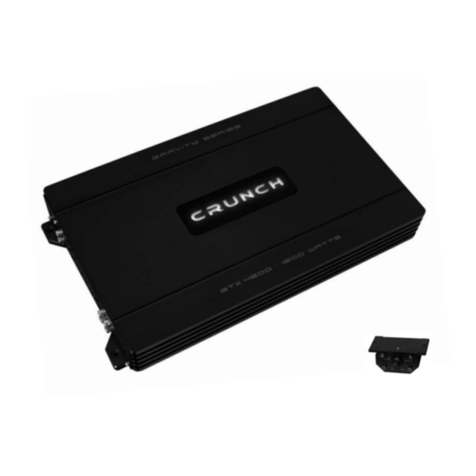
Crunch
Crunch GTX 2400 owner's manual

Rockford Fosgate
Rockford Fosgate Pro Series bd1001P Installation and operation
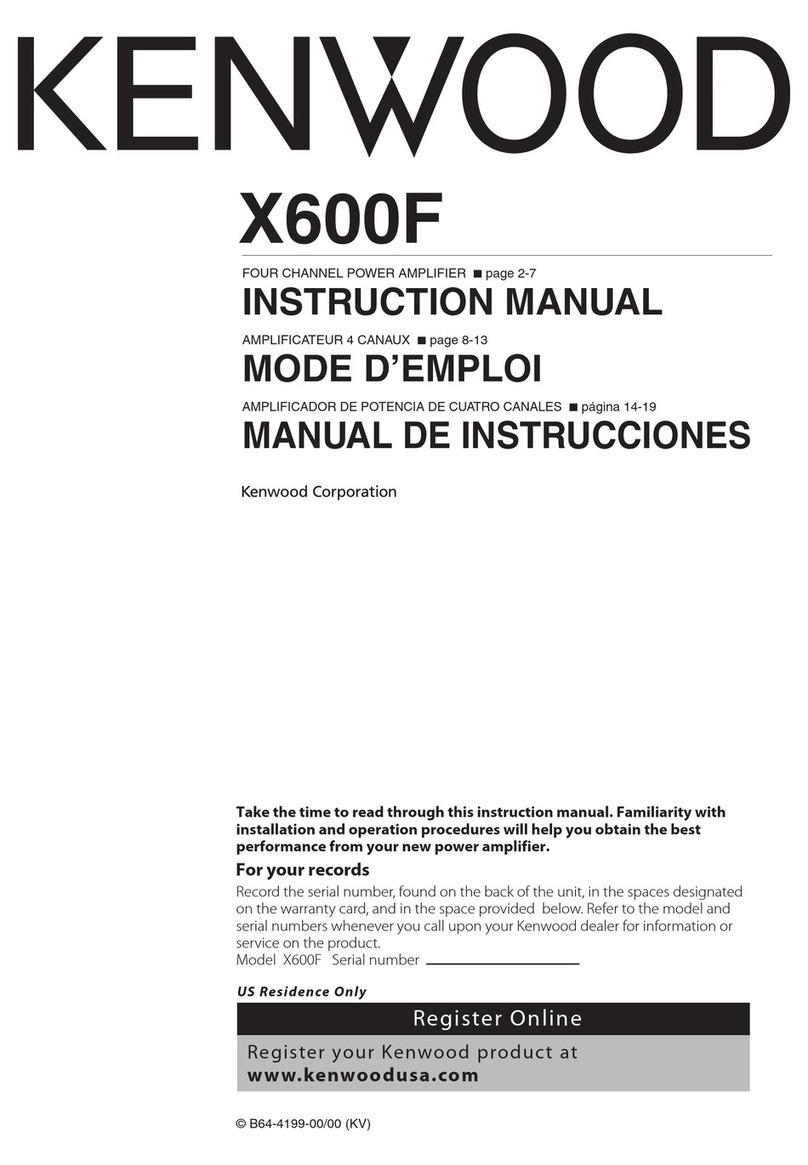
Kenwood
Kenwood X600F - Excelon - Car Amplifier instruction manual
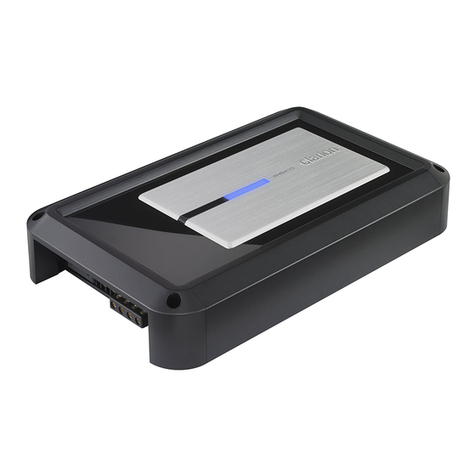
Clarion
Clarion XH5410 Owner's manual & installation manual

Blaupunkt
Blaupunkt PA2100 install guide

Audison
Audison Voce AV due owner's manual
